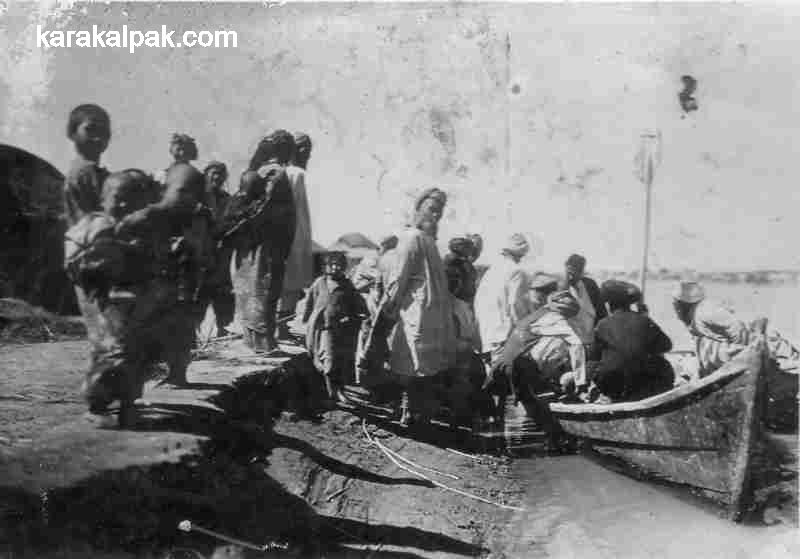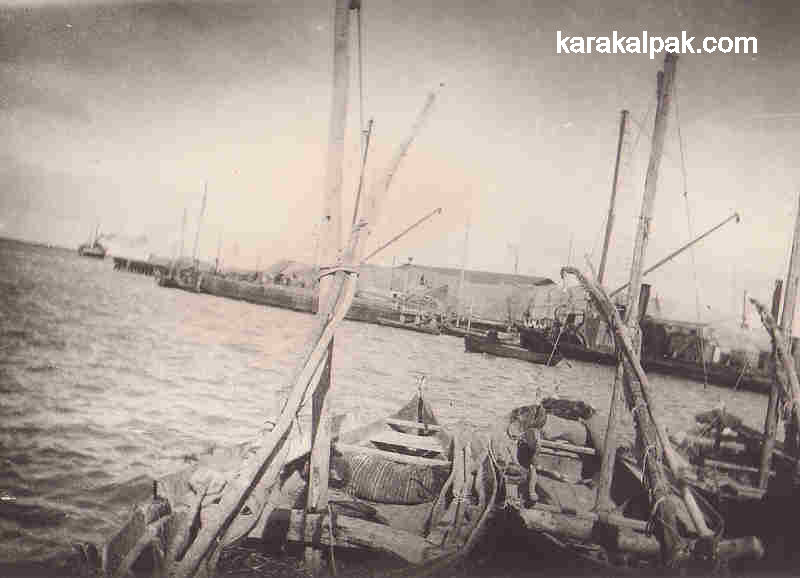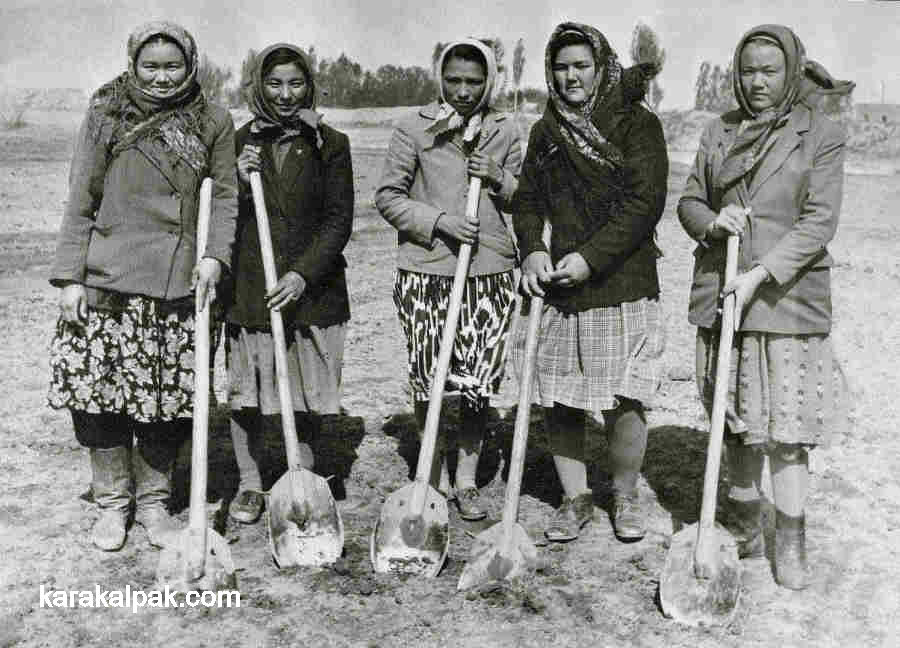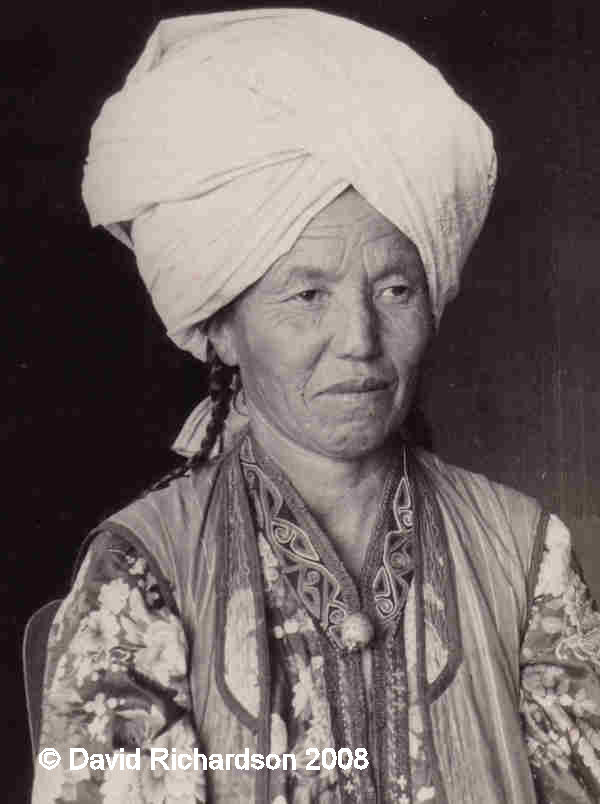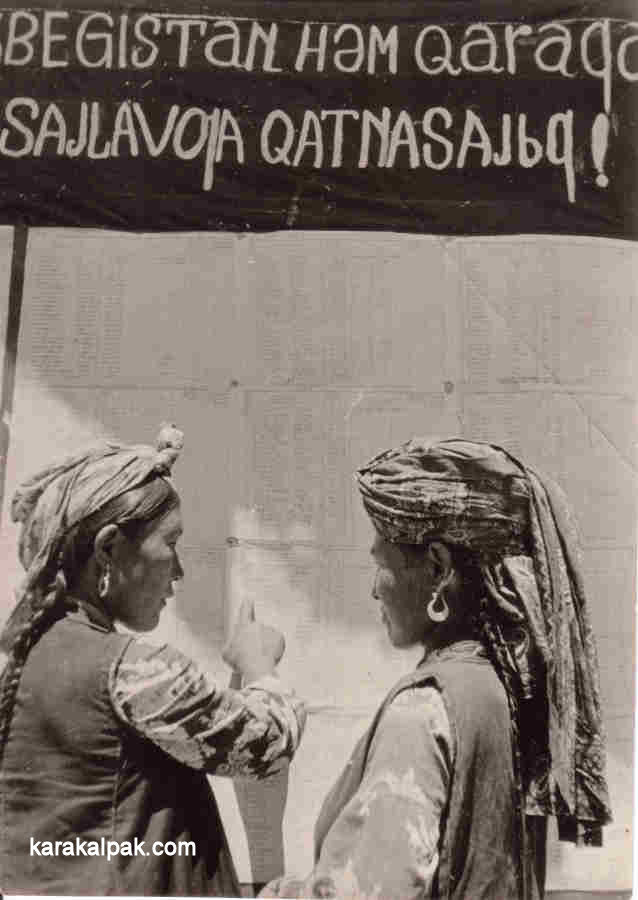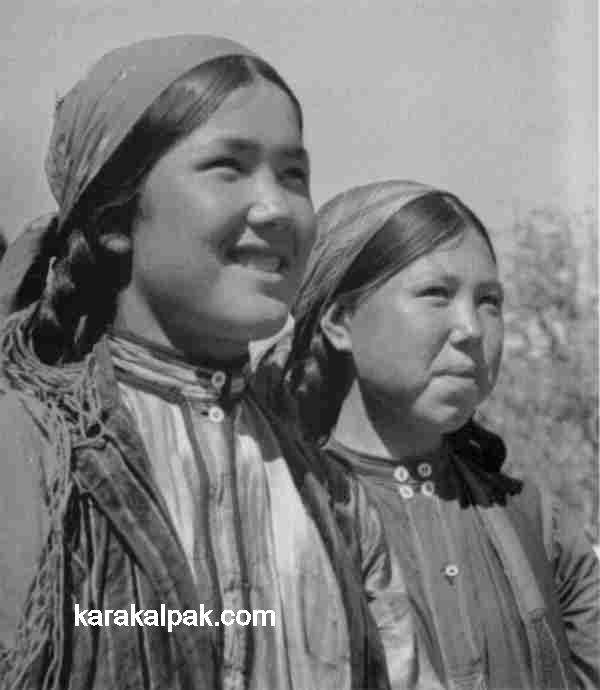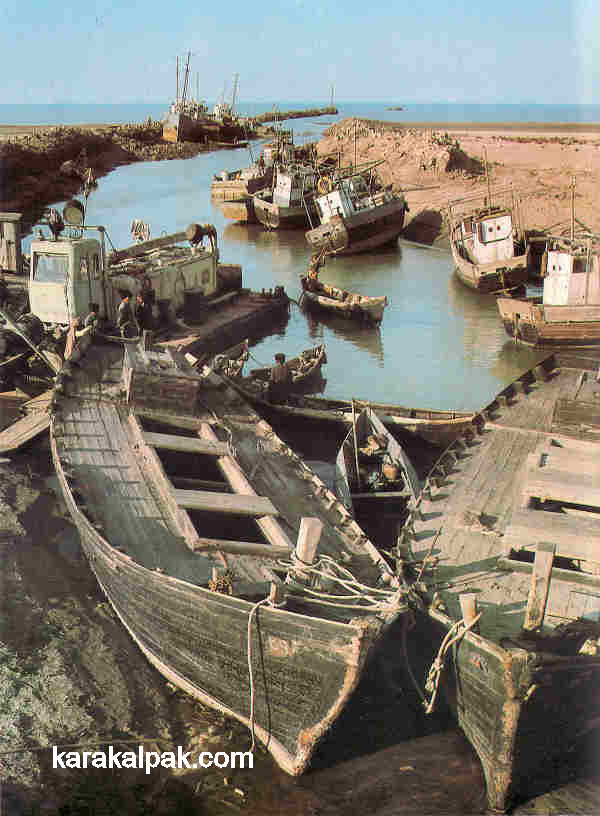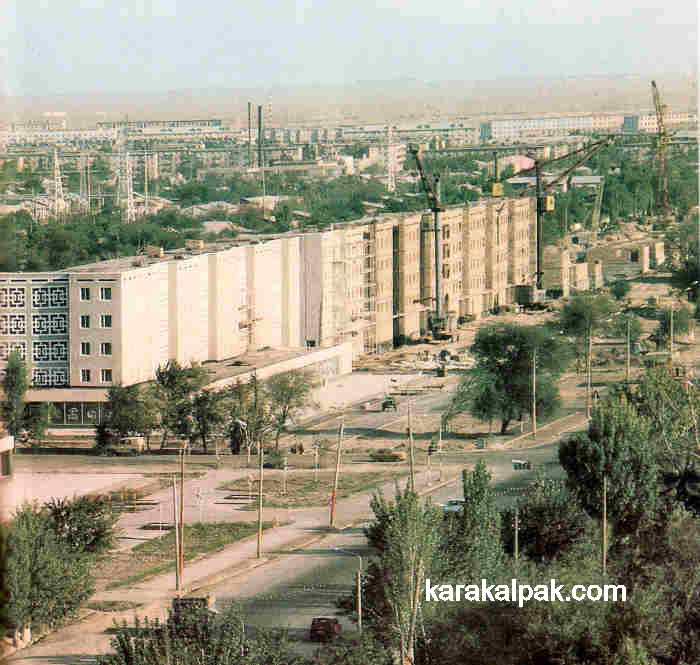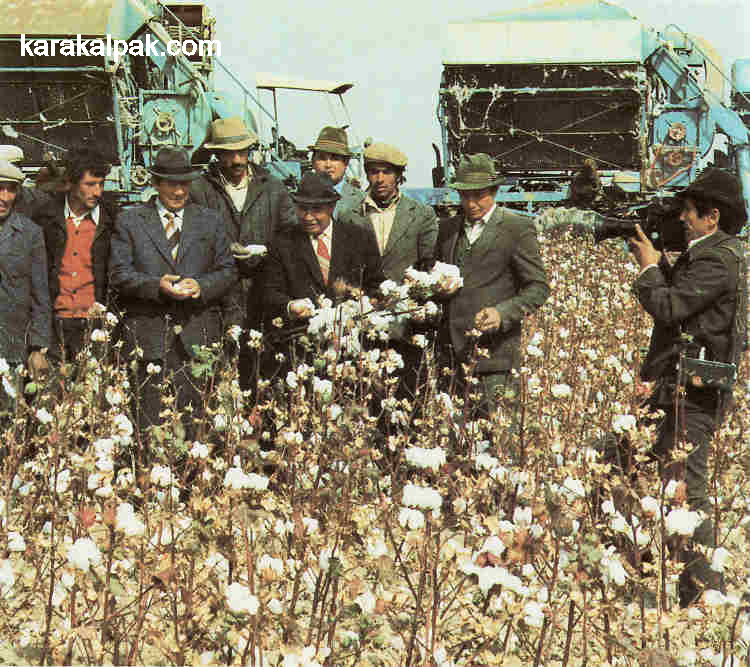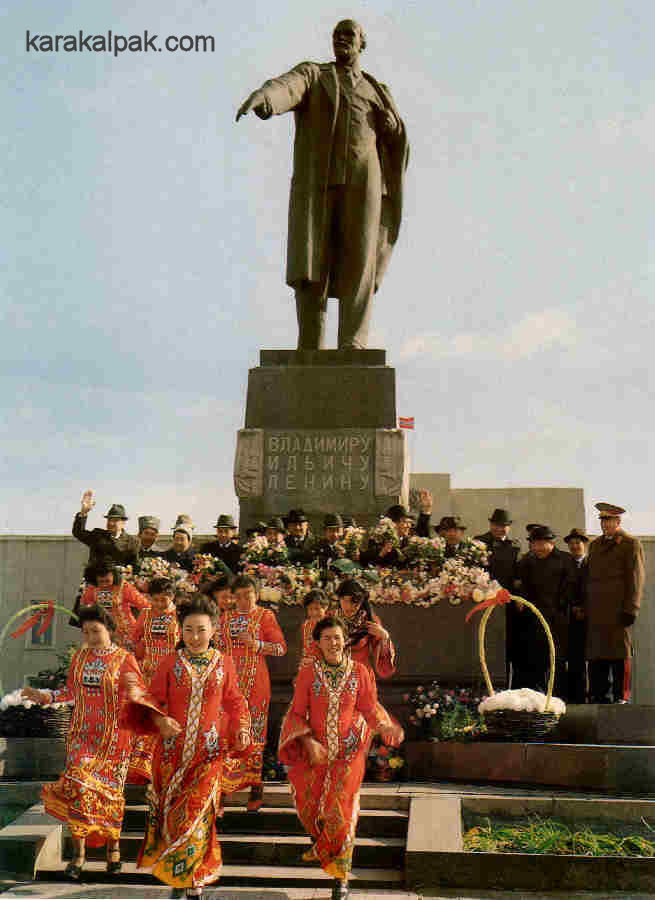|
Contents
Khorezm and the October Revolution
The Khorezm Soviet Republic
The Stalin Years
The Post-War Period
Depths of the Cold War
The Collapse of Communism
References
A poster of Karl Marx overlooks a Soviet parade in Lenin Square, No'kis, in the early 1980s.
Khorezm and the October Revolution
The task of outlining the history of Khorezm and the Karakalpaks during the relatively recent Soviet period is in someways harder than describing more
distant events. The published Soviet versions of events assert that, with the exception of a few religious or bourgeois reactionaries, the peoples of
Central Asia wholeheartedly welcomed the Revolution and gave it their full support. The accounts are so distorted and one-sided that they would be
laughable were it not for the chilling realization that either misguided loyalty or terror resulted in several generations of authors substituting
fantasy for reality. Sharaf Rashidov, the former Communist First Secretary of Uzbekistan, makes the point for us admirably in his book "Soviet
Uzbekistan", published shortly before his demise in 1983:
"The victory of the Revolution marked a turning point in the history of the peoples of our country. The cleansing wind passed over Turkestan as well,
sweeping away with it the dirt and the scum of the old world, a world of cruel social and national oppression, feudal and capitalistic exploitation,
the tyranny of the khans, rich landowners and tsarist officials, and lack of rights for the working people."
"A new epoch had come an epoch of intellectual renaissance, a rapid and steady rise of the economy and development of all national and ethnic cultures
of Central Asia, an epoch of friendship, brotherly co-operation, and mutual assistance of the peoples of our country."
Penned by one of Uzbekistan's most corrupt politicians, these words sum up the appalling hypocrisy of the former Soviet regime.
Sharaf Rashidov, First Party Secretary of the Uzbek SSR, 1959 to 1983.
Yet the alternative view was also biased, although not in such a ludicrous manner. Non-Soviet historians have argued that the response of the local
population varied from indifference to violent opposition and that their incorporation into the Soviet system was only achieved through Russia's
overwhelmingly superior military strength. What we lack in both accounts is any record of events from the point of view of the endemic population who
generally played a minor role in the events that shaped their lives for the next 70 years. Following independence, local people are now much more
willing to describe openly what life was like in Khorezm during the Soviet period and some local academics are researching the period from a new
standpoint. The danger now is that history is being rewritten, not always objectively, from the new nationalistic Uzbek, Turkmen, or Karakalpak
perspective. At the end of the day there is no substitution for an eyewitness account, but unfortunately only a handful have been published. Sadly
few of today's citizens can remember as far back as the events that followed the 1917 October Revolution but many remember the Stalin era, both before
and after the Great Patriotic War.
While the Russian Provisional Government attempted to continue the war against Germany throughout 1917, they were submerged by increasing lawlessness
at home. Finally, on 6 November, a group of Bolsheviks led by Trotsky stormed the Winter Palace and ousted the Provisional Government, opening the
way for Lenin to establish the All-Russian Congress of Soviets.
It was a time of major crisis. Russia had been devastated by the war. The Empire was disintegrating Poland, the Ukraine, Estonia, Finland, Moldova
and Latvia all declared independence, as did Georgia, Armenia and Azerbaijan following the humiliating peace treaty signed with Germany in 1918. Soon
Russia would be engulfed in the Civil War between the Red and White factions - for and against the Revolution.
Within Central Asia itself the main political response to events taking place in Russia was centred on the Russian community in Tashkent. At that time
the city consisted of two parts, the old Muslim town with a population of about 200,000 and the new and adjacent Russian quarter with a population of
about 50,000. Following the so-called revolution of February 1917, and the abdication of the Tsar, the official ruling Turkestan Committee effectively
vied for power with the unofficial Tashkent Soviet. As early as September, before the October Revolution, the Tashkent Soviet had proclaimed its
authority over the whole of Russian Turkestan and within days of the Revolution members of the Turkestan Committee had been arrested by local activists.
By the end of November the Tashkent Soviet had gained complete control of central Tashkent. Following the creation of a soviet government in Petrograd,
the soviets of Turkestan and Bukhara aligned themselves with Tashkent and a Council of People's Commissars of the Turkestan Region was formed, headed by
a prominent Bolshevik. Certain Tashkent Jadidists, including some future leaders such as the two Bukharans, Abdurauf Fitrat and the younger Faizulla
Khojayev, threw their hand in with the Bolsheviks, although many others wanted Muslim not Communist rule.
Amazingly neither the former Turkestan Committee nor the new Tashkent Soviet contained a single representative of the local Muslim population, essentially
excluding 95% of the population of Turkestan. Yet it was clear that many of the Jadidists, and others who could speak on behalf of the Muslim
majority, saw the Revolution as an opportunity to gain autonomy and self-governance, although not necessarily complete independence from Russia. An
All-Russian Muslim Congress that had convened in Moscow during 1917 had already proposed a democratic federal republic to govern the Muslim territories,
while a Muslim conference in Tashkent demanded Muslim autonomy for Turkestan within a Russian federal republic. In December an Extraordinary Muslim
Congress held in Khokand (the Khanate located in the Ferghana Valley) established an independent regional government led by young nationalists. It
declared its desire for a Pan-Turkic confederation of progressive Central Asian states, for the education and Westernization of its people, and for the
modernization of its religious establishments. At the very same time a vast and peaceful demonstration for autonomy took place in Tashkent.
Yet the Tashkent Soviet had held a Congress in November 1917 aimed at establishing the foundations of Soviet power in Turkestan, during which they
arrogantly resolved that Muslims should be excluded from all government posts! The Muslims appealed to Moscow to rein in the Tashkent Soviet, but
Stalin refused to intervene in this distant dispute. Locally the Tashkent Soviet clearly saw the Khokand government as a direct and highly popular
threat to its own existence and at a Congress of Soviets held in Tashkent in January 1918 it was declared "counter-revolutionary". Within a month
Red Army forces had surrounded and invaded the town, causing considerable loss of life and leaving only a handful of fugitive survivors to tell the
tale. By April 1918 the Bolsheviks in Tashkent had formed the Turkestan Autonomous Soviet Socialist Republic.
The extinction of the Khokand government sent a brutally clear message to those Muslim leaders still contemplating national self-rule within Central
Asia. Resistance to Soviet rule now went underground in the form of a mujaheddin-like guerrilla movement, which the Bolsheviks derogatorily termed
the Basmachis, a term normally reserved for bandits and murderers. The first Basmachi campaign had taken place in Ferghana during 1918 and 1919 and
moved on to Tashkent in 1920. However the Basmachis were very poorly equipped and lacked co-ordination, even more so than the Red Army - itself a
rag-tag mixture of Russian army deserters and East European ex-PoWs. The arrival of Enver Pasha, the former Minister of War for the Ottoman Empire
during the First World War, at the end of 1921, provided the Basmachis with some dynamic leadership for a brief period, during which they managed to
take control of both Dushanbe and Bukhara. Enver Pasha soon built up a considerable following and succeeded in defeating the Red Army on several
occasions. He established links with the Basmachis in Ferghana and with the Yomut leader, Junaid Khan, who was fighting the Bolsheviks in the Qara
Qum, close to Khorezm. However this high profile campaign was short-lived and the Bolsheviks managed to ambush Enver Pasha in the Pamirs during 1922.
Even so the Basmachis continued their campaign in the region, continuing to embarrass the Soviets into the mid-1930s.
The successful suppression of the aspirations of the Muslim majority is all the more remarkable given the fact that Central Asia had been effectively
isolated from Moscow and Petrograd during the Civil War. The relatively small Turkestan Red Army had been forced to fight not just the Basmachis but
the more professional soldiers of the White Army, not just on one but on several fronts. As early as November 1917 officers from the former Imperial
army formed the first White opposition forces in south-eastern Russia, cutting communications between Tashkent and Moscow. By March 1918 the Civil
War had begun. Ural and Orenburg Cossacks took over control from local soviets and the moderately socialist Mensheviks formed an interim government
in the Volga city of Samara. By August the whole of south-east Russia was under the control of anti-Bolshevik forces, with General Dutov in control
of Orenburg. With the railway from Central Asia effectively blockaded and Moscow desperate for cotton supplies, they even had to revert to camel
caravans to ferry cotton from Khorezm to Emba. Because of the desperate lack of local fuel several railway engines were converted to burn fish that
had been dried in the port of Aralsk for the purpose. The smell must have been incredible! Meanwhile, in Transcaspia, the local soviet had been ousted
from power by anti-Bolshevik forces in Ashgabat, who then called on support from British forces in Persia. This cut the railway line to the Caspian.
The Turkestan Red Army was split, with some troops fighting Dutov on the Aktjubinsk Front north of Emba, some fighting to the east in Semirechye, the
largest force trying to contain the uprising in Ashgabat, and with a residual force left behind to maintain control in Tashkent. Even in the capital
the Bolsheviks were not secure a rebellion in January 1919 was violently suppressed, causing many deaths, which rang alarm bells in Moscow. In
retrospect it is remarkable that the Red Army eventually prevailed, a result that owes more to the lack of co-ordination between its opponents than
to its own prowess.
The behaviour of the Soviet regime after the Revolution was in sharp contrast to the promises that had been made before the Revolution. Lenin and other
leading Bolsheviks had frequently denounced Tsarist imperialism over the years and, once in power, Lenin promised racial equality and national
self-determination for Russia's many subject peoples. By July 1918 the Bolsheviks had already established the Russian Soviet Federated Socialist
Republic, or RSFSR, with its own constitution based on a free federation of independent nations. One of Lenin's other early decisions was to establish
a new Commissariat of Nationalities under the Chairmanship of Joseph Stalin, possibly an unfortunate choice. However like many other early promises
from the new regime, these ideals proved to be short-lived. Turkestan and the Steppe Region had become home to about 2 million Russian immigrants who
wanted to remain an integral part of Russia. The region had huge natural resources and the Bolsheviks had no desire to leave this vast region open to
British Imperialist interests. There was also increasing concern about the potential challenge that could emerge if the various Muslim territories of
Central Asia should unite to form a pan-Islamic State. By early 1919 the new regime had dropped any idea of independent nation states, let alone Muslim
states, in Central Asia.
From the first-hand account of Frederick Bailey, a Lieutenant-Colonel in the Indian Army who had been sent to Tashkent in charge of a small diplomatic
mission to make contact with the new Bolshevik rulers, the Russian city had become a dangerous and sinister place during the period of his residence
in 1918 and 1919. The city was under curfew and everyone was under suspicion, with the spies and agent provocateurs of the CheKa looking everywhere
for anti-Bolshevik sympathizers. Once found an enemy of the regime might be disposed of with no more than a pistol shot to the head or, if lucky, might
be sent to the forced labour camp at Perovsk. People's identity papers were checked constantly while the bourgeoisie were evicted from their homes and
stripped of their property and furniture by fanatical commissars. During the 1919 famine all of the trees across the city were cut down for fuel and
the Bolsheviks even stole food from the peasants, leading to a critical response from Lenin. In the centre of Tashkent the statue of General Kaufmann
had been something of an embarrassment during that year's May Day celebrations and in July it was removed from its granite pedestal to be replaced some
months later with a giant hammer and sickle.
It took time for these major events to have an impact on the backwater of Khorezm, which was way behind Khokand in terms of its political awareness.
There was no radical Russian enclave in Khiva to spread the Revolution, the merchants of Urgench being all anti-Bolshevik, along with the officers of
the local Russian garrison. Earlier that year Lenin had told the Seventh Party Conference that he did not want the peasants of Khiva to live under
the Khan's rule, but the Tashkent Soviet did not regard either the Khivan or Bukharan Khanates as a priority and for a while they remained independent.
Isfandiyar Khan, with the support of Colonel Zaitsev and Junaid Khan, made the most of the situation by hunting down local Jadidists and other radicals.
In November 1917 a number of Jadidists seem to have been put on trial (the evidence is not clear) but were saved from execution. Despite the fact that
the internal situation within the Khanate remained unstable with the Turkmen raids continuing unabated, discipline within the Russian garrison had
fallen to such a low level that Zaitsev ordered the pro-Bolshevik infantry regiments back to Petro-Aleksandrovsk. Zaitsev had originally intended to
spend the winter in Khiva and to then join up with Dutov's forces in Orenburg, but his Cossack forces were growing increasingly restless and he decided
to change his plans. In January 1918 he left Khiva for Charjou, where he gained reinforcements in readiness to attack Tashkent while its forces were
engaged in overcoming the uprising in Khokand. But when he encountered Soviet troops just outside of Samarkand, Bolshevik supporters persuaded his
Cossacks to lay down their weapons, forcing Zaitsev to flee as a fugitive. After reaching Ashgabat he was quickly spotted and arrested.
The departure of the Russians left Isfandiyar Khan's regime totally reliant on Junaid Khan, who commanded the only pro-Khivan armed forces in the
Khanate. Junaid Khan now acted through the timid Isfandiyar to increase his grip on power. The Majlis was abolished and in May the Jadidist
leaders who had earlier been put on trail were executed. The handful of remaining Jadidists, who had since gone underground, escaped to Tashkent to
form a small revolutionary committee in exile, known as the Young Khivans.
Junaid Khan was selfishly ambitious, opposed to the Bolsheviks and reformers not on idealistic grounds, but because they threatened his control over
Khorezm. While Isfandiyar was left as the titular head of state, Junaid Khan began to install his own system of control, just like the inaqs
of old. He set up a network of military commanders to rule the separate regions of Khorezm, using the services of the established court officials but
reporting directly to him. He began the construction of a palace at his village of Bedirkent, close to Takhta, which effectively became the new
capital of Khorezm. Taxes were raised, especially for the Uzbeks, who were also forced to undertake compulsory labour service to clean the irrigation
canals. All Turkmen were ordered to arm themselves at their own expense and to make themselves available for military service. Junaid faced a limited
rebellion from his old rival Yomut leaders, but these were soon overcome and by late summer he was firmly in control of the local Yomut population.
At the end of September he raided Urgench and stole money and property from the local Russian merchants and banks, arresting some Russians in the
process. However the Russian garrison at Petro-Aleksandrovsk had just been reinforced with Red Army soldiers under the command of a new Bolshevik
military commissar, Nikolay Shaydakov, who ordered Junaid Khan to release his Russian captives. Junaid Khan complied but warned Shaydakov not to
interfere in Khivan affairs, realizing that he was still vulnerable to Russian intervention, especially if Isfandiyar appealed to Petro-Aleksandrovsk
for help. Junaid decided that his security would be enhanced with Isfandiyar out of the way, especially as he could then rule through Isfandiyar's
more malleable and grateful brother, Sayyid Abdullah. He instructed his eldest son to go to Khiva and assassinate the Khan.
A month or so earlier Junaid had refused a request from Ashgabat to slow down the Soviet advance on Transcaspia by attacking the garrison at
Petro-Aleksandrovsk he felt that the mission was too dangerous, especially since Russian reinforcements could be quickly despatched by steamer from
Charjou. At the same time he knew that the nearby garrison posed a constant threat to his position. As autumn turned to winter navigation on the
Amu Darya became impossible and Junaid Khan made his move. Turkmen forces crossed the Amu Darya at six separate locations and laid siege to
Petro-Aleksandrovsk. But, quite unexpectedly, a steamer from Charjou managed to get through with reinforcements and the siege was broken after only
eleven days. In the following spring Russian troops returned from Charjou and defeated Turkmen forces on the left-bank in the region of Pitnyak.
The Petro-Aleksandrovsk Soviet was keen to annex Khiva, but Tashkent needed all the troops it could find for the Transcaspian front. Instead they sent
a peace mission to Khorezm and negotiated a settlement with Junaid Khan, known as the Treaty of Takhta, which was signed on 9 April 1919. Khiva
would remain independent and would re-establish normal diplomatic relations and trade with Russia, who in turn would offer an amnesty to all Turkmen
charged with anti-Soviet activity. However relations with Russia remained difficult with Junaid reacting uncooperatively to a request to supply troops
for the Transcaspian campaign and then refusing to accept the Russian diplomatic representative sent to Khorezm in accordance with the terms of the
Treaty. That summer also saw a revolt by a detachment of Cossacks based at Shımbay, who allied themselves with local Karakalpaks to take control
of the entire delta region, from No'kis up to the Aral coastline. When Shaydakov and his troops steamed down the Amu Darya to No'kis to put down the
revolt they were annoyed to be fired upon by Junaid's Turkmen supporters. After relieving No'kis Shaydakov headed back to Petro-Aleksandrovsk in fear
of another Turkmen attack following the onset of winter. In fact Junaid Khan was already discussing the possibility of such an attack with the rebels
in Shımbay.
However, for the Soviets, the tide was turning. By October the European Red Army had defeated Dutov and Soviet forces from Tashkent had reached Qizil
Arvat in Transcaspia. Moscow had only just established a new government for Turkestan, the Commission for the Affairs of Turkestan, and the focus now
began to turn on the still independent territories of Bukhara and Khiva. For once the smaller province of Khiva was singled out as the priority, given
its outright hostility to Russia and its ongoing instability, another revolt by Junaid's Yomut rivals having only just broken out again in Xojeli and
Kunya Urgench. At the same time the constant flow of disaffected radicals from Khiva had swollen the ranks of the Young Khivans in Tashkent from just
over a dozen to a militia of around five hundred. In November the Turkestan military authorities sent Skalov, their new military representative for
Khiva, to Petro-Aleksandrovsk to organize an invasion, just as a relief force from Charjou was extricating Shaydakov's forces from No'kis where they
had been under attack by a combined force of Turkmen and rebel Cossacks.
Skalov crossed the Amu Darya on 25 December with 430 soldiers, including some leading zealots like Faizullah Khojaev. They took Khanqa and Urgench
without a struggle, only to find themselves besieged in Urgench by Junaid Khan's troops for the following three weeks. Meanwhile Shaydakov's army of
400 soldiers defeated the Cossack and Karakalpak rebels at Shımbay before crossing the river to take control of Xojeli, where their numbers were
swollen by rebel Turkmen forces opposed to Junaid Khan. After the fall of Kunya Urgench Junaid Khan retreated to Bedirkent to face Shaydakov's army
from the north and Skalov's army to the south. After a two-day battle at Takhta Junaid Khan escaped into the Qara Qum. Khiva was taken on 1 February.
With the Red Army in control Sayyid Abdullah Khan, the very last Qongrat Khan and member of the Chinggisid dynasty was forced to abdicate with his power
transferred to a temporary revolutionary committee led by Hajji Pahlavan Yusupov. Only a tiny minority of the Young Khivans was Communist, yet Tashkent
immediately responded to this factions request for the establishment of a soviet republic in Khorezm. A political delegation was quickly despatched
to conduct elections to a nationwide congress of soviets. On 27 April the First All-Khorezm Congress of Soviets met and agreed to abolish the
Khanate in favour of an independent Khorezm People's Soviet Republic. The Young Khivans were now in control of Khorezm, heading 10 of the 15 available
departments, and with the chairman of their central committee, Hajji Pahlavan Yusupov, acting as premier.
Later that year the Khorezm People's Soviet Republic concluded an extraordinary formal treaty with the RSFSR, which superseded all previous agreements
and withdrew all former Russian claims and rights over the territory. Russia recognized Khorezm's full independence, but offered a voluntary economic
and military union and assistance with economic and cultural development, including a campaign against illiteracy and educational resources. All
property, land concessions, and rights of usage of the Russian government, Russian citizens, or Russian companies were transferred to the new government
of Khorezm without compensation. Even the assets of the Amu Darya Flotilla were transferred to a joint Khorezmian and Bukharan river authority. Soon
teachers, doctors, and military instructors arrived from Tashkent and elsewhere with supplies and equipment. Work began to establish 35 new schools
and 15 adult colleges, as well as Khorezm's first national university. Canals were repaired, bridges were built and the telegraph was extended. It
was all too good to be true.
The Khorezm Soviet Republic
As we have just mentioned, in September 1919 a new Turkestan Commission was established in Tashkent tasked by Lenin to rally the previously
alienated Muslim masses to the Soviet cause. It was led by Shalva Eliava, a Georgian with little knowledge of Central Asia and soon ran into problems
with the local Turkestan Communist Party, which now had a Muslim majority. The Muslim communists were keen for Turkestan to gain more autonomy as a
Soviet Republic of Turkic Peoples, with its own Turkic Red Army.
These ideas were anathema to General Mikhail Frunze, who arrived in Tashkent the following February, effectively taking control of both the Turkestan
Commission and the Turkestan government. As commander of the Red Fourth Army as well as the Turkestan Red Army, Frunze had only just gained control
of Siberia after having earlier defeated Dutov's forces in the Urals. He was now determined to restore order in Turkestan, revive its economy and draft
a new constitution that would be acceptable to Moscow. Frunze needed support from the native Muslim majority and quickly dismissed some of the
anti-Muslim government leaders, courting popularity by distributing food and seed to the ordinary people. Frunze rejected the idea of a Turkic republic,
seeing the petty bourgeois views of the Muslim leaders as unrepresentative of the Islamic majority. Rather than unite the separate Oblasts
of Turkestan, along with the Amu Darya Military Division and the former Khanates of Khiva and Bukhara, Frunze believed it should be divided along
ethnic lines, between the Uzbeks, Turkmen, and Kyrgyz. He told Lenin that the main obstacle was a shortage of reliable native leaders.
General Frunze only remained in Tashkent until September 1920, when he was ordered back to the Russian southern front. During his short stay the
Turkestan Army had regained control of Transcaspia and had overthrown the Khanate of Bukhara, installing Faizullah Khojaev as the President of a new
Bukharan Soviet People's Republic. Within months Frunze had cornered General Wrangel's army in the Crimea, forcing it to evacuate to Constantinople.
With the end of the Civil War in sight, Khorezm was still polarized by the enmity between the settled Uzbek and the nomadic Turkmen populations. The
Young Khivans who dominated the government in Khiva were all Uzbeks and they wanted to see the supporters of Junaid Khan, who had seized control of
the Khanate, punished. About one hundred Turkmen were arrested and shot and others were disarmed, while punitive raids were directed against villages
suspected of supporting the Turkmen rebels. The Turkestan Commission were concerned about unfolding events and sent a team of investigators to Khiva,
led by Valentin Safonov, a former Bolshevik army commander. He was alarmed to find that the Young Khivan government had no liking for Marxist socialism
whatsoever and was doing its best to block its introduction. It had even gained control of the nascent Khorezmian Communist Party.
Safonov convened an all-Turkmen Congress in the small left-bank Khorezmian town of Porsa, securing the support of the Turkmen leaders to overturn the
Young Khivan government. A mass demonstration was engineered in Khiva against the government in March 1921, providing an excuse for the Red Army to
capture the government offices and to oust the Young Khivans. A governing provisional revolutionary committee was formed, consisting of two Uzbeks,
one Turkmen, one Qazaq and a member of the Komsomol. Elections were held to form a Second All-Khorezm Congress of Soviets, which met in May to form
a new government, devoid of Young Khivans. Many of the latter had fled into the Qara Qum to join Junaid Khan, whose following increased dramatically
after Safonov's intervention into Khorezmian affairs.
The Russians kept a close eye on subsequent events, purging the supposedly independent government and the local Communist Party at will. In October
several members of the former government were executed or imprisoned for counter-revolutionary activities, while others were arrested during the
year-long purge that followed.
By now Lenin and the Central Committee were fully in control and it was time to establish an administrative structure and constitution for the new
Bolshevik State. Although Marx had argued that nation states would disappear as workers united across international boundaries, the government of such
a huge ethnically and linguistically diverse territory was unthinkable without strong provincial subdivisions. Lenin had promised "self-determination
for the toilers" and he intended to deliver this through his new nationalities policy, by transforming the RSFSR into a federation of national states
that would no longer be independent but would be "partially autonomous". Yet before this policy could be implemented the federation was already being
enlarged by the addition of new Bolshevik republics. The ratification of the Union Treaty on 30 December 1922 joined the RSFSR to the Ukraine,
Belarus and the Transcaucasus to form the Union of Soviet Socialist Republics, or USSR.
Lenin had already written to the Communist Party in Tashkent in 1920, asking them to investigate how many national republics should be established in
Turkestan and how they should be named. The task of ethnically dividing up Turkestan was something like the equivalent of trying to divide up a
multi-ethnic country like Afghanistan today. The idea of ethnically defined nations with fixed borders was quite alien to the essentially tribal
people who lived there, whose concept of identity was based on family and clan ties and whose concept of territory was linked to their farm settlement
or grazing lands. When the Bolsheviks sought advice from the renowned Orientalist Vasiliy Barthold he told them that the idea ran contrary to
historical experience and would be a great folly. However the politicians were motivated by the need to divide and rule and to eliminate any
justification for separatism or Turkic or Islamic unification. Some foresighted Islamic leaders were dangerously proposing that European Marxism was
unsuited to the tenants of the Muslim world and would simply encourage Russian chauvinism. Using information from Russian ethnographers,
apparatchiks in Moscow divided the RSFSR into artificial "nations", ensuring that none of them could dominate its own region alone, save for
Russia itself. Each was required to have an external foreign border, to emphasize that they were nations and not just states. In Central Asia this
resulted in the creation of six artificial nations based around six former tribal confederations: the Qazaq, Kyrgyz, Karakalpak, Turkmen, Uzbek, and Tajik.
The opinions of the local people counted for little in this decision. Khiva fought hard to maintain the integrity of the ancient land of Khorezm for
a number of years, but was constantly overruled by Moscow.
The Soviet Government remained concerned that both Khorezm and Bukhara remained hotbeds of counter-revolution, under the control of the bourgeoisie
rather than the proletariat, despite the expulsion of the Young Khivans. Stalin wanted them transformed into "fully socialist" societies, so it was
decided in 1922 that the whole of Turkestan, including Khorezm and Bukhara, should operate as a single economic unit. The Central Asiatic Economic
Council was formed to integrate all of the region's agriculture, irrigation, post and telegraph systems, trade and monetary systems. Meanwhile
Moscow took back control of the Amu Darya Flotilla. Finally the Communist parties of Khorezm and Bukhara were to be merged with that of Russia.
The Russian Central Committee sent a senior hard-line Bolshevik to Khiva to conduct a ruthless purge of both the party and the government. The
membership of the Khorezmian Communist Party was reduced from a few thousand to a few hundred, with the expulsion of all merchants, tradesmen and
landowners. Following the purge, in October 1923, the constitution of Khorezm was changed to disenfranchise "all non-toiling elements". Restyled as
the Khorezmian Soviet Socialist Republic, Khorezm had finally qualified as a "socialist" republic and now formally requested membership of the USSR.
Within three years it had been transformed from an independent ally to a docile puppet of the Russian regime.
Junaid Khan kept up his violent opposition through the winter of 1923. In December the new Khorezmian government faced a major revolt in response
to increased taxes and the introduction of secular schools. Junaid Khan, supported by ten thousand or more Uzbek and Turkmen rebels, laid siege to
Khiva for nearly a month, recapturing it with the help of local clerics and merchants for a short period in January 1924. Tashkent ordered in a
3,000-strong Red Army camel cavalry detachment, supported by nine aircraft, and the demonstration was suppressed. Following instructions from Moscow,
the government reduced taxes and permitted the medressehs and maktabs (where children studied religious texts) to reopen. Junaid Khan agreed
to a treaty, which he maintained until some of his partisans were executed. As a result of that action he resumed his opposition until a general state
of mobilization was declared against him. Following a six-week campaign in the Qara Qum, Junaid Khan's resistance was broken. He finally fled to
Persia in 1928.
It is a pity that we do not have a trustworthy account of life in Khorezm at this very unusual time - after 1917, entry into the two Khanates of Khiva
and Bukhara became almost impossible for European travellers. The foolhardy Austrian carpet dealer, Gustav Krist, who had formerly been a PoW in
Central Asia, did manage to get close, thanks to a chance meeting with some Yomut tribesmen on a Caspian beach in northern Iran in 1923. The Yomut
smuggled him into Turkmenia, where he borrowed the identity and papers of an old Austrian friend living in Qizil Arvat, who was a naturalized ex-prisoner
of war. Krist travelled across the desert from Merv to Eldzhik (Iljik) on the Amu Darya just to the south of Khorezm, escorted by a troop of Desert
Police on camelback, then took the steamer 70 km upstream to Charjou. Even at this early date Charjou had already become a large cotton-growing
centre, huge stretches of land having recently been planted with cotton instead of corn. At the time of his visit the town was busy with the cotton
harvest, with many caravans and boats bringing in raw cotton from the surrounding villages to be processed at some of the new cotton-ginning mills that
had recently been built in the town. The local people were still practising their Muslim religion as normal, but now the red flag flew above every
government building, red pennants flew from every shop door and pictures of Lenin adorned the chai khanas. The former Beg had been driven out
of his citadel in 1920, which had already been turned into a museum. When Krist reached Bukhara he found that it was still a thriving commercial and
religious town, with 21,000 future mullahs still receiving Qur'anic instruction in its medressehs. However there were strange juxtapositions, with
Soviet slogans and portraits hung up beside shelves of Islamic texts, and with even the Imam at the Mir Arab Medresseh having a poster in his cell
proclaiming "Proletarians of all Lands Unite!" One disturbing observation was that the mosaics around the lower reachable parts of many of the
monumental buildings had been removed, having been previously sold to dealers and collectors.
Lenin died in January 1924, missing the endorsement of the new Constitution of the USSR by ten days. Local Communist parties, including those of
Turkestan, Khorezm and Bukhara, approved the proposed national delimitation of the USSR and that following autumn their respective governments gave
formal assent to the measure. Each new "nation state" was to become a Soviet Socialist Republic, or SSR, with its own constitution, its own legislative,
executive, and judicial institutions, and its own party structure. Autonomous Soviet Socialist Republics, or ASSRs, would have some degree of autonomy
but would be subordinate to an SSR. Each SSR would be divided into provinces or Oblasts. Each would be named after its largest ethnic
population. All would be members of the USSR.
Within Central Asia, the former Khanates of Khiva and Bukhara were the main losers in the process, probably deliberately so, their territories being
divided up between the new national entities. Khorezm was split into three separate parts. The left bank region of Dashoguz and Kunya Urgench went
to the Turkmen SSR (including a large community of Uzbeks), while the whole delta region and much of the right bank was designated the Karakalpak
Autonomous Oblast within the Kyrgyz ASSR of the RSFSR, with its capital at To'rtku'l. This was a positive development for the Karakalpaks,
who finally gained a homeland, despite the fact that they made up less than 40% of its population. The Kyrgyz ASSR also included the Kara-Kyrgyz
Autonomous Oblast. The remaining part of Khorezm was essentially the heart of the old Khiva Khanate and included Khiva, Urgench and Hazarasp.
It was renamed the Khorezm Oblast and was incorporated into the Uzbek SSR, which also happened to include the Tajik ASSR. The Uzbek SSR
essentially consisted of most of the former three Khanates of Khiva, Bukhara and Khokand. It is likely that the constant conflict between the Uzbek
and Turkmen populations of Khorezm contributed significantly to the Russian decision to partition the country.
Over time these various Central Asian entities have been renamed and regrouped, although the basic system remained in place until the dissolution of
the USSR. The Kyrgyz ASSR was renamed the Kazakh ASSR in 1925. The Tajik ASSR became an SSR in 1929, splitting away from the Uzbek SSR; the Kyrgyz
Autonomous Oblast became an ASSR in 1926; the Karakalpak Autonomous Oblast became an ASSR in 1932 and was transferred from the Kazakh
ASSR to the Russian SSR; and both the Kazakh ASSR and the Kyrgyz ASSR became SSRs in 1936. Following persistent lobbying from Tashkent, Moscow decided
to transfer the Karakalpak ASSR to the Uzbek SSR in 1936. This was a popular move for the Uzbek population of the province but a retrograde one for
the Karakalpaks who have much more in common ethnically with the Qazaqs.
In practice the political boundaries of Central Asia had been totally redrawn. The old tribal territories and their rulers had become obsolete,
creating the opportunity for a new political elite to emerge. Those in the vanguard of the local Soviet movement soon learnt that acquiring a position
of status in this new political environment offered unprecedented political and economic rewards. The new Uzbek SSR rapidly came under the domination
of activists from the Tashkent, Ferghana and, to a lesser extent, Samarkand regions. Thus the First Party Secretary, Akmal Ikram, came from the
Tashkent Oblast, and all of the First Party Secretaries up to 1959 came from either Tashkent or Ferghana. From the very beginning politicians
from Khorezm (and Bukhara) were viewed with suspicion in Tashkent, while the Surkhandarya and Kashkadarya Oblasts were regarded as too
backward to exert any national influence.
As early as 1920 Lenin had approved a plan to regenerate cotton cultivation in Central Asia, primarily to support the Russian textile industry.
However the political events of 1920 to 1922 led to massive economic disruption in both Khorezm and Bukhara, with cotton exports to Russia falling
to just 5% of their pre-First World War level. Agriculture did recover, although even by 1924 exports from Khorezm had only reached 30% of
their 1913 level. During the early 1920s cooperatives were set up to repair and expand the irrigation network and attempts were made to reform
land ownership and water rights. Some land was confiscated from rich beys. Not surprisingly Tashkent and Ferghana were deemed to be the
most suitable locations for new manufacturing industries.
The onset of Lenin's illness had meant that three old-time Bolsheviks, Zinoviev, Kamenov and Stalin became the de facto ruling triumvirate of the USSR,
effectively in control of the Politburo. After Lenin's death divisions opened up between the ruthless and ambitious Stalin and his two unsuspecting
colleagues. Stalin had already outmanoeuvred the once powerful Trotsky, and now groomed new supporters on the Politburo. Secure in his position,
Stalin now demoted Kamenov for publicly attacking his economic policy and in the following year dismissed Zinoviev over a scandal involving the
organization of a Red Army opposition group. One year later both Zinoviev and Trotsky were expelled from the Party and the way was open for Stalin
to purge his opponents en masse.
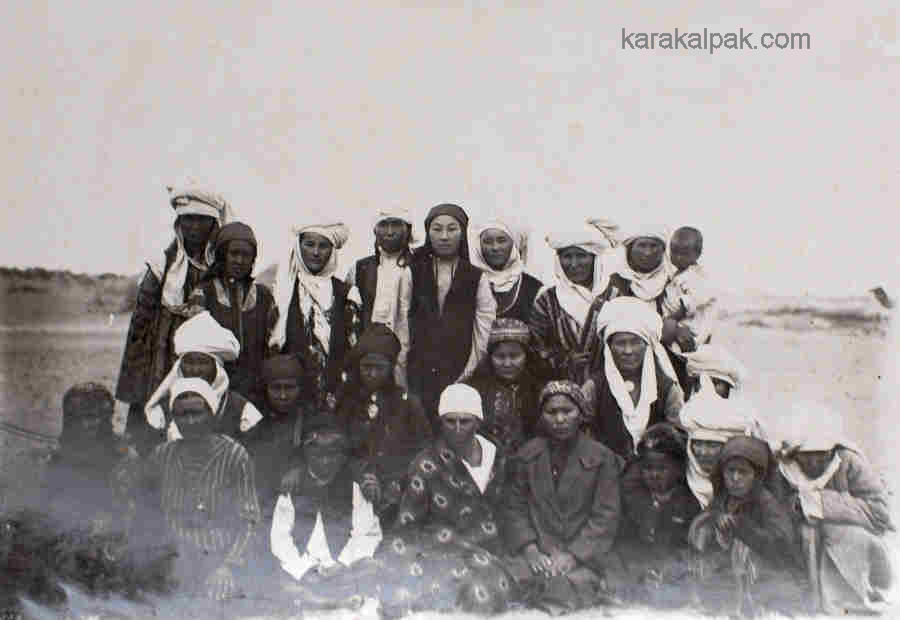
|
Karakalpak women and children photographed by Aleksandr Melkov in 1928-29.
Image courtesy of the Regional Studies Museum, No'kis.
At the XV Party Congress, in December 1927, Stalin announced that the fundamental objective was to change the agricultural economy by amalgamating small
peasant farms into large-scale enterprises and to open new factories and expand the industrial base. Only weeks later a crisis developed over a major
shortfall in the government's domestic purchases of grain, threatening a famine among the urban population. Stalin blamed the kulaks, the
land-owning farmers and peasants, for withholding grain and disrupting Soviet economic policy. "Emergency measures" were ordered by the Politburo,
involving the raiding of peasant farms, illegal searches and the requisitioning of hidden grain stocks. In July 1928 Stalin called on the party to
"strike hard at the kulaks".
In fact 1928 became a crucial year. Stalin was unsettled by the spectre of chronic famine and was also concerned about the stagnation of industrial
production. His biographer described him at this time as living in a half-real, half-dream world of statistics and indices in which no target and no
objective seemed to be beyond his or the party's grasp. His favourite saying was that "there are no fortresses that cannot be conquered by the
Bolsheviks".
The outcome was the first Five Year Plan. It ambitiously set a target of a 250% increase in industrial output and a 150% increase in
agricultural production. But it was far more than an economic plan it was to be the first real implementation of Marxist ideology, with the
abolition of the private sector and the elimination of the exploitative class. Agriculture would be collectivized throughout the USSR. The farmlands
and property of the hated kulaks would be expropriated and held collectively, eliminating the hard core of anti-Soviet resistance in the
settled agricultural areas. In the steppes, deserts and mountains of Central Asia it would break the resistance of the nomads - the Turkmen, Kyrgyz,
and especially the Qazaqs, who wanted nothing more than the expulsion of the Russian settlers from their lands. The strong culture of these pastoral
people made them impervious to Soviet indoctrination; they were mobile and uncontrollable and had no desire for promised Soviet improvements such as
schools. The Soviets realized that they could only overcome this resistance through the compulsory "stabilization" of the nomadic populations of
Central Asia. This would involve the expropriation of the lands and herds of the rich beys, and the forced settlement of the nomads on
collective and state farms.
In December 1929 celebrations were held to mark Stalin's 50th birthday. The slogan of the day was prophetic: "Stalin is the Lenin of today!" Now only
one man was in charge of Soviet affairs.
The Stalin Years
The First Five Year Plan was adopted in April 1929 at the XVI Party Conference. The objective was nothing less than to change the minds and values of
the entire nation, by eliminating private property and destroying traditional ways of living and working. It aimed to make every worker, peasant and
nomad an employee of a state-controlled enterprise. Once the peasant had lost his attachment to his land and the nomad his attachment to his livestock,
they would at last realize that their true interests lay in the advancement of their collective and the advancement of the state. It was dubbed the
"Second Revolution". It was the beginning of Soviet totalitarianism, where state control would be exercised forcibly over every aspect of economic,
social and cultural life.
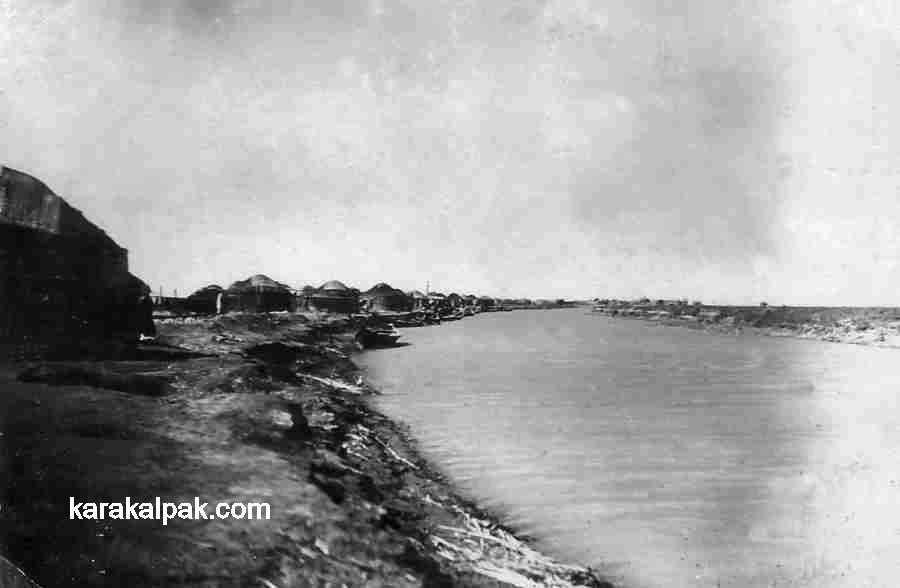
|
Awıl of Mu'yten Karakalpaks at Qazaqdarya, photographed by Melkov in 1929.
Image courtesy of the Regional Studies Museum, No'kis.
Mu'ytens waiting by river ferry boats at Qazaqdarya. Photographed by Melkov in 1929.
Image courtesy of the Regional Studies Museum, No'kis.
It turned out to be an unmitigated disaster for the Soviet Union as a whole. The rural economy descended into pandemonium. In many villages farm
collectivization was resisted passionately. Families slaughtered their cattle, smashed their implements and burned their crops. In some cases villages
were surrounded by GPU secret police units and relocated at gunpoint. Whole communities were uprooted and moved. The so-called kulaks were
deprived of their property and then barred from joining the new collectives. Some kulaks were sent to concentration camps in the Aral
region the GPU secret police opened one camp at the old military prison on Vozrozhdeniye Island in the middle of the Aral Sea and one or more at Aralsk.
Other kulaks were deported to remote regions of Siberia or were resettled on low-quality land, and some were even murdered. Often the
implementation of these directives was left to untrained and uneducated officials and party underlings, who often misunderstood the purpose or process
of collectivization and acted in a crude and heavy-handed way. The process was also open to considerable abuse and corruption and was an excuse for
local people to settle old scores, or to attack peasants who were resistant to the cause or just owned a few cows and chickens.
Peasants who resorted to violence or resisted collectivization were treated as criminals and were herded into labour camps, and were subsequently
employed as "forced labourers" on building canals and railways. Even obedient workers were not immune from coercion. Stalin had introduced a new
labour policy in 1929 under which workers could be directed to work in specific factories or collective farms.
The greatest resistance to collectivization occurred among the true pastoral nomads, particularly the Qazaqs and the Turkmen. When the policy was
announced, many livestock-breeders simply killed their herds rather than hand them over. Others simply packed up and migrated out of the country.
There were many violent local uprisings and many Party activists were killed. The results were staggering. In the Qazaq ASSR the number of cattle
fell from 7.4 million in 1929 to 1.6 million in 1933, while the number of sheep fell from 21.9 to 1.7 million over the same period; by 1935 only
63,000 camels remained out of over 1 million. By 1941 only 885,000 horses remained from an original population of 3.5 million.
The resulting cataclysmic collapse in agriculture gave rise to the 1931-33 Soviet famine. Statistics show that out of a population of 6.2 million
in 1920, some 1 million Qazaq people died during the collectivization and subsequent famine. However some Qazaq scholars believe the number could
have been as high as 2 or even 3 million! In addition possibly one million people migrated into China, Mongolia, Afghanistan, Iran, and Turkey, although
some returned later. Statistics show that the number of Qazaq households fell from 1,233,000 in 1929 to 565,000 in 1936. The death toll in the Ukraine
was even higher. Even Stalin himself admitted privately to Churchill that over 10 million kulaks had probably disappeared as a result of
collectivization!
Not surprisingly within Khorezm the greatest resistance to collectivization came from the nomadic Turkmen population. Sadly the full story of the
uprisings across the Turkmen SSR has never been told, having been completely suppressed by the Soviets and ignored in the West. Perhaps we will never
know the details. There seem to have been several bloody revolts against collectivization in the 1930 to 1931 period, a mass culling of livestock and
an upsurge in the local Basmachi campaign. The late 1920s had also seen the development of a subversive movement, known as Turkmen Azatlygi, or
Turkmen Liberty, which was anti-Soviet and anti-collectivization, and gained considerable local support, both from the "toiling population" and from
intellectuals and senior politicians. Stalin responded to these events in the usual way, with iron-fisted repression and a subsequent purge. During
the 1930s almost an entire generation of intellectuals was liquidated in the Great Terror, including most of the senior Communist leadership, as we
shall shortly see.
On the other hand in northern Khorezm the implementation of collectivization seems to have progressed quite smoothly. Most of the Karakalpaks in
the delta lived within extended families that were essentially already operating as a collective unit, and the collectivization process involved little
more than combining several family groups into a single economic unit. Furthermore many ordinary peasants were glad to be rid of their former greedy
and oppressive landlords. An uprising in Taxta Ko'pir in 1929 has been previously misinterpreted as an indicator of local resistance, but recent
research has suggested that this was little more than a domestic disturbance sparked by a feud over a woman. This parallels the findings of the
American researchers, Kamp and Zanca, who have recently been interviewing old people in Namangan and Nurata. In hindsight many respondents supported
collectivization because of the material improvements that followed in their daily lives, and because of the introduction of universal schooling for
boys and girls that occurred at about the same time. Of course these supporters were the survivors looking back on events retrospectively; the
kulaks who were killed or exiled might well have told a different story!

|
A street close to the bazaar in To'rtku'l, winter of 1934.
Image courtesy of the Savitsky Museum, No'kis.
New collective enterprises were established progressively throughout Khorezm during the 1930s. Two types of farm appeared: the state farm, or
sovxoz (an abbreviation of sovetskoe khoziaistvo) and the collective farm, or kolxoz (an abbreviation
of kollektivnoe khoziaistvo). The former was the full property of the Soviet government, whose manager operated it with hired labour; while
the latter was supposed to be a self-governing co-operative made up of peasants who voluntarily pooled their means of production. There was also
the toz, a society for joint land cultivation, where the peasants kept title to their own plot of land, livestock and equipment and
the artel, where each peasant retained his own livestock and a private garden plot. The fishermen at Moynaq and Aralsk were also
organized into kolxoz.
Qayıqs at the port of Moynaq, probably photographed in the 1930s.
Image courtesy of the Savitsky Museum, No'kis.
The original intention was that the sovxoz would be the model to which all farm collectives should aspire. In reality the enormous
resistance to full collectivization forced the authorities to accept the artel as the most common, indeed almost the universal type of
collective. By 1933 about 96% of Soviet farms were essentially of the artel type, acting principally under the umbrella of
kolxoz rather than sovxoz. This somewhat defeated the original purpose of the whole collectivization exercise.
Leading workers from the sovxoz named after Lenin, Xojeli region, 1930s.
Image courtesy of the Regional Studies Museum, No'kis.
Even so production targets were still rigidly enforced and Stalin even introduced military tactics to encourage their achievement, known as the
"shock quarter" the final quarter of the calendar year, when an all-out effort to boost output was organized. In September 1933 there was a
conference in Karakalpakia to rally the shock-workers on the collective farms. The insistence on target achievement coupled with the elimination of
private ownership led to illogical behaviour, such as sheep being sheared to maximize wool quotas at the onset of winter in the knowledge that the
animals would be unable to survive the winter.
Zbay Doshanova, a cotton-picker from the kolxoz named after Telman, Shımbay region.
Classed as a great toiler or Stakhanovka, she used to pick up to 120kg of cotton per day. Image courtesy of the Savitsky Museum, No'kis.
Khorezm had been selected as one of the priority regions for expanding cotton production from as early as 1929 because its soil and climate were seen
as being ideal for growing cotton. One aspect of the 1929 Plan was to achieve "cotton independence" or cotton self-sufficiency. The argument was that
it made sense to encourage the Central Asian collectives to switch from grain, which could be grown anywhere in Russia, Ukraine, or Siberia, to cotton,
which could not be grown elsewhere in the Soviet Union . This led to enormous pressure being applied to the new collectives to plant cotton, pressure
that they resisted because the price for cotton was low. At first political commissars were assigned to the collectives to ensure compliance but then,
in 1934, cotton prices were raised by 500%. Cotton immediately became highly attractive, being referred to as "white gold" and the cotton acreage
soon increased. But there was still a problem: the crop yields remained dismally low. This was partly because canals had been built without proper
allowance for subsequent drainage, coupled with poor irrigation practice, which resulted in the land becoming salinized the age-old curse of farming
in Khorezm. Now the priority was to raise cotton yields and this was achieved by the increasing application of mineral fertilizers from 1935 onwards.
Sadly little was done to resolve the salinization problem.
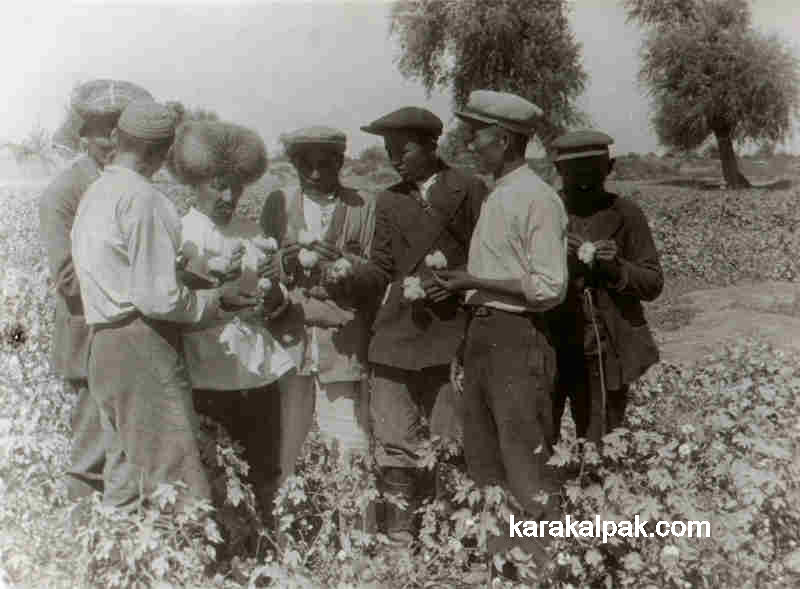
|
Officials inspecting the Karakalpak cotton crop.
Image courtesy of the Savitsky Museum, No'kis.
Massive changes were also being forced upon the social life of the people. After initial concessions to Islam after the Revolution, the early 1920s
saw the first Communist anti-religious campaign get underway across Turkestan. However while some Muslims were encouraged to join the Party, the
majority simply became more discreet in the way that they pursued their faith. In 1927 the Soviet government introduced the hujum, or
offensive, against all social practices considered to be oppressive to women, such as the marriage of under-age girls, the bride price, the tradition
of seclusion and the veil. In strictly orthodox centres like Khiva the seclusion of women was still strictly observed. Women's rights became
enshrined in law and various initiatives were launched to involve women in the social, economic and political life of their district. The veiling of
women was seen as the most overt symbol of female oppression, and women were encouraged to discard the veil. There were mass burnings of
paranjas in towns like Samarkand and Tashkent, resulting in a strong male backlash, with a few women being attacked and disfigured. However
in many cases these events were just a gesture; Party supporters took their wives to rallies to burn their veils and made them wear new ones the
following day! The main force of change was economic as women became increasing integrated into the workforce, so the old traditions became
increasingly eroded, especially in the urban areas.
Anti-religious pressure intensified during the 1930s, partly through a drive known as the Movement of the Godless. Muslims were showered with a
wave of propaganda and the Qur'an and the hajj to Mecca were both officially banned. Many mullahs were persecuted during the purges between
1932 and 1938; religious land was confiscated and mosques, medressehs and maktabs were closed. However it would have been provocative to
knock the old religious buildings down, so they were just left to decay. The teaching of religion had already been forbidden in state schools long
before compulsory primary education was introduced in 1930. The year before that had seen the introduction of the Latin alphabet, undermining
traditional religious teaching by outlawing the holy medium of Arabic. Of course Islamic belief continued, but increasingly in private, with unofficial
elders acting as mullahs at weddings and funerals. It became unwise to display strong Islamic beliefs publicly. Some men began shaving their beards
and moustaches and wearing neckties, while some women started to wear Russian costume and to leave their hair uncovered.
In the more remote areas there was more resistance to these pressures, especially in Khorezm and among nomadic tribes with a robust traditional
culture like the Turkmen, and officials were more willing to turn a blind eye. A Soviet ethnographical survey of the Khorezm oblast in 1954-56 showed
that many traditional customs were still alive, even at that late stage. It was ironic that at the time that the traditional way of life of the
people was being forcibly overturned, Soviet academics were beginning to venture out from Moscow and Leningrad to study their vanishing customs and
material culture. From the late 1920s onwards archaeologists had begun to investigate the many ancient sites across Khorezm, including Urgench.
The first historical and ethnographic expedition to Khorezm seems to have arrived in 1929, organized by academician Preobrazhenski for the Russian
Association of Research Institutes of Social Sciences, RANION, with Sergey Tolstov as one of its junior members. By 1931 a local ethnographic section
had even been established at the scientific research institute in To'rtku'l. Tolstov returned in 1932 as the head of an ethnographic expedition
organized by the Museum of the Peoples of the USSR, which lasted until 1934, a trip that convinced him that he was really onto something big. He
returned to Moscow to lobby for the resources required to put together a much more focused and long-term research project, which would become the
famous Khorezm Archaeological and Ethnographic Expedition. Tolstov headed its first field trip to Khorezm in 1937, commencing a programme of study
that would continue until the collapse of the Soviet Union in 1991.
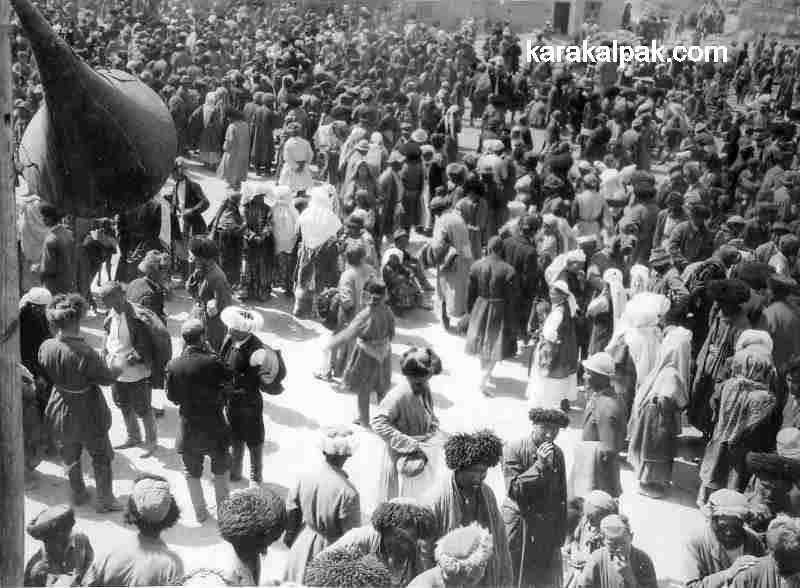
|
Shımbay bazaar, possibly late 1930s.
Image courtesy of the Regional Studies Museum, No'kis.
It is hard to judge the full effect that collectivization and all the other changes had throughout Khorezm as a whole. The published Soviet histories
of the region are silent on the matter, only being obliged to record the government's successes. They list the dates of decisions, decrees, congresses,
and conferences; they name the officials and party members involved; they list the openings of cotton depots, meat-packing plants, printing houses and
research institutes, even the opening of the Karakalpak State theatre in 1930! History was reduced to nothing more than a sequence of improvements,
all engineered by the regime on behalf of a thankful and adoring nation.
Some sense of the real history of the region can be gauged from piecemeal facts and the accounts of some of the people who lived through it, albeit in
an anecdotal way. Women who were taken out of the home to work in the cotton plantations experienced some of the biggest changes. Although this was hot
and tiring work, it gave women independence for the very first time, along with a social life and some private income of their own. While Westerners
complain that the Soviets destroyed the traditional culture of Khorezm, we have met elderly women who have told us that as young girls they had no
desire to stay in their homes to embroider and weave for their weddings. Another aspect that is overlooked is that although many tribal and clan
leaders were killed or removed during collectivization, these were not always popular individuals and local peasants were often relieved to see them go.
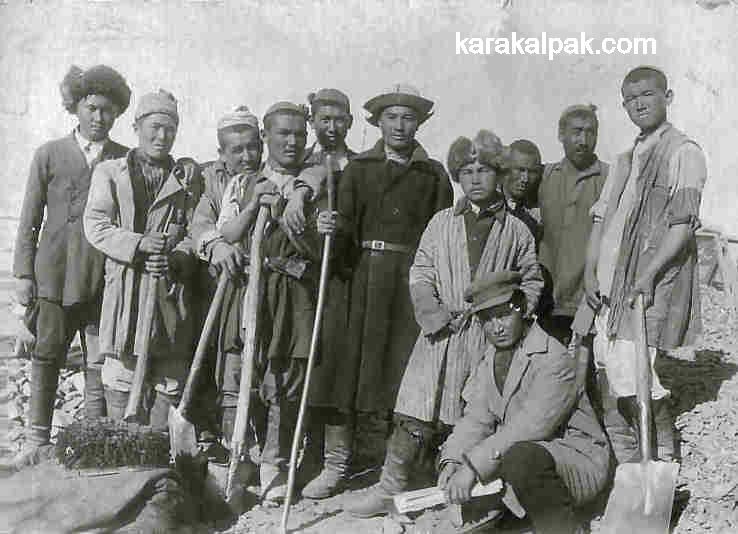
|
Komsomol Brigade named after the 16th anniversary of the October Revolution constructing the Qızketken canal.
Image courtesy of the Regional Studies Museum, No'kis
Western travellers had not been allowed to visit Soviet Khorezm since the First World War, so independent accounts of life in the region during the
1920s and 1930s are scarce. We are fortunate to have one good first-hand report written by Lyman Wilbur, a young civil engineer from Idaho. In order
to fulfil the cotton ambitions of the 1929 Plan, the Soviet government were keen to increase the acreage of irrigated farmland throughout Uzbekistan
and had hired Wilbur as a consultant on a two-year contract, during which he was based in Tashkent. He and his companions undertook a survey of
Khorezm in the August of either 1930 or 1931, first travelling by train to Charjou and there embarking on a small paddle-wheel motorboat called the
Chaika (Seagull) to sail down the Amu Darya to Khorezm. On reaching Charjou they observed a modest amount of traffic along the river, with local
100-foot-long single-masted native skiffs powered by huge square sails ferrying timber, cotton, oil barrels and other goods into the port, along with
Khorezmian liquorice root destined for the USA. The Russians were now operating a number of small motorboats, like the Chaika, on the river and were
also constructing five tractor-powered dredgers along the riverbank. Wilbur also observed a large bucket excavator dredge. After leaving the
irrigated, mosquito-infested banks around Charjou, they travelled for two days through a landscape dominated by desert and rolling sand dunes, with
the sole exception of the small oasis town of Dargan Ata. As soon as they reached the very southern part of Khorezm they had their first encounter
with some of the region's many irrigation problems. Many of the canals were simply not deep enough, so although they could channel water from the Amu
Darya during the flood season, their bottoms were too high to capture water from the river during those times when the water level was low. At the same
time, the canals were silting up so quickly that the farmers spent most of their time clearing them out instead of farming the land. At Pitnyak most
of the irrigation depended on crude and inefficient shigir water wheels, driven by a blindfolded camel or donkey, which scooped up water in
ceramic jars.
During his survey Wilbur had ample opportunity to see the local people across Khorezm and painted a picture of a relatively stable, albeit poor
community, the only danger coming from banditry, especially from Turkmen tribesmen. He also noticed that there were considerable differences between
different towns and villages. For example in some towns the women wore elaborate headdresses and brightly coloured or brightly embroidered robes,
while in others the costume was exceedingly plain. It was the busy weekly bazaar when he arrived in Pitnyak and the men were dressed in robes and fur
hats while the women had ankle-length dresses that looked faded and dirty. Lyman Wilbur next visited Hazarasp, just a little way north of Pitnyak, and
found that most of the town was now built outside of the walls of the old city. His attempt to photograph the fruit sellers in one of the covered
streets was hampered by crowds of curious men and boys wearing immense woolly hats. From here he crossed the Amu Darya to Shoraxan and found that
the Russian engineers were having problems with their conservative Turkmen and Uzbek labourers. The Russians wanted to build long straight canals
instead of the sinuous winding canals that had been constructed by the local people in the past. But the labourers refused to work on them, believing
that water would not run in a straight line because it could "see itself" in the distance!
After paying a courtesy call to the Russian Governor in To'rtku'l, Wilbur crossed back to the left bank of the Amu Darya on the Chaika and sailed down
the Shavat canal to New Urgench, the capital of Khorezm, to be entertained by the Irrigation Department Office with a lavish banquet. Wilbur and his
colleagues now had exclusive use of a Renault "desert car", one of the half dozen automobiles in Khorezm at the time. The next day they drove through
the desert to Khiva, finding one village along the way engulfed in sand. In Khiva some of the mosques had already been commandeered for non-religious
uses, one having been procured as an artist's studio by a Russian painter. The local metal workers had already been collectivized and an individual
artisan could no longer sell his own goods. Instead of offering traditional items of carved brass they were now selling simple utensils made from
copper sheeting.
The second expedition from New Urgench was westward to the lands formerly irrigated by the dried-up Darya Lyk. Much of the land was polluted with
"black alkali", where the sodium carbonate (soda) in the soil had dissolved the humus. All the depressions were filled with stagnant water, providing
breeding-grounds for malaria-carrying mosquitoes. A subsequent trip to Dashoguz was more positive. The centre had the appearance of a boomtown, with
much construction underway on a new Russian quarter, and with a newly built flourmill and airport. However, because of the risk from bandits, they
needed an escort of three policemen to drive to Gurlen and rendezvous with their boat. Now they sailed further downstream, passing the Sultan Uvays Dag
and the ruins of Gyaur qala before pulling in at Qıpshaq. Wilbur describes this as an exceptionally dirty and disease-ridden town, where most of
the children had scalp, eye, or nose afflictions. The bazaars had little for sale other than melons. They stopped overnight at Taqıatas and were told
that tigers and wild boars could still be found in the jungle along the right bank. Arriving at Xojeli the next day, they found it as dirty and
disease-ridden as Qıpshaq and described it as having appalling poverty, being the poorest region they had seen in Central Asia. Even so, the town's
womenfolk were bedecked with nose ornaments and gaudy dresses. The region between Xojeli and Konya Urgench was absolutely barren, broken only by the
large cemetery of Mizdahkan, and Kunya Urgench was no more than a few mud houses beside the ruins of Gurganj.
They reached Shımbay by boat from Xojeli, passing by tree-lined canal banks, a pleasant contrast to the bleak deserts that normally lined the
river. During a stop for engine repairs Wilbur got the chance to visit some Karakalpak and Qazaq yurts. Shımbay was now the capital of the
Karakalpaks and was cleaner than most of the other towns they had seen. Some of the mud buildings had been whitewashed and others had glass windows.
There was even an electric lighting system in operation. From Shımbay they returned to the Amu Darya and then set course for the Aral Sea.
The surrounding land soon became swampy and the various delta channels began to diverge. The occasional yurt was the only sign of human habitation.
In the river the reed-beds became so thick that it was impossible to distinguish the water from the land and they had difficulty following the channel.
They finally arrived at the Aral seaport of Qantoz'ek that night, at the mouth of the Amu Darya, opposite the island of Tokmak Ata. At daybreak they
transferred to the ferry "Turkistan", fortunately just in time for its departure later that morning. There had just been a storm and the largest ship
on the Aral Sea, the "Kommune", lay in the outer harbour waiting for the rough seas to subside. The "Turkistan" had no more than ten deck passengers
and a few other cabin passengers on board and soon hit rough water, making most of the passengers seasick. The ship rolled and pitched to such an
extent that Wilbur had to hang on to his berth throughout the night, but by the following morning they were in the lee of the islands, including the
prison island of Vozrozhdeniye. They reached the port of Aralsk the following night, where they finally caught the train for their return to Tashkent.
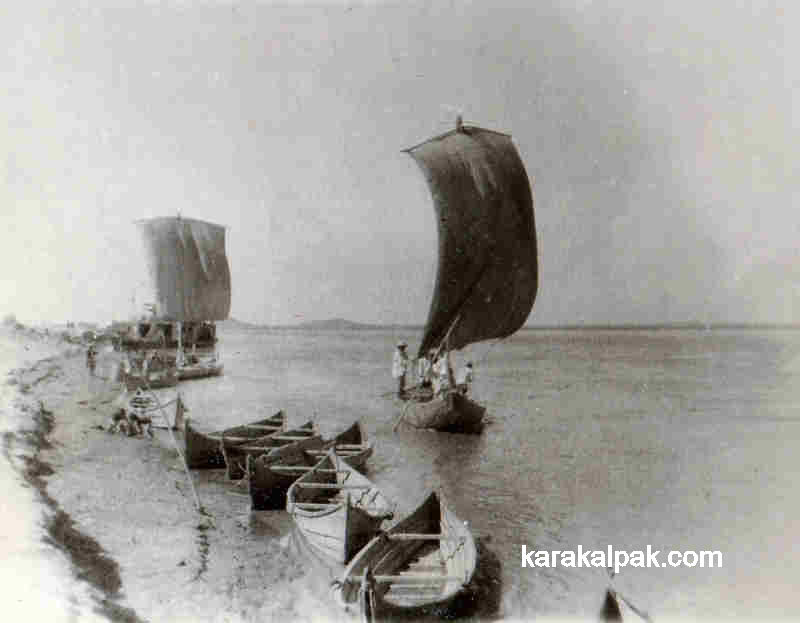
|
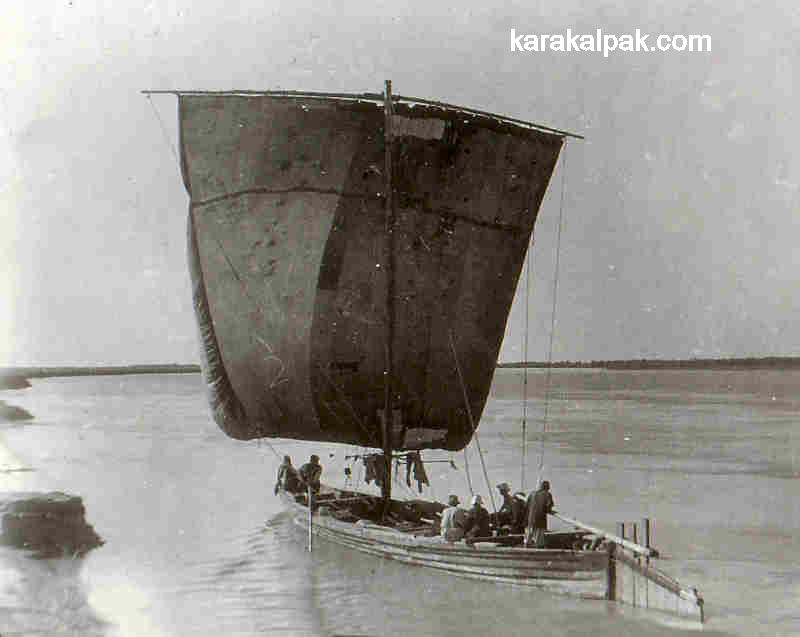
|
Qayıqs on the Amu Darya, probably 1930s.
Images courtesy of the Regional Studies Museum, No'kis.
Another rare Western visitor at this time was the black left-wing American poet, Langston Hughes, who spent one year in Soviet Central Asia between
1932 and 1933. He travelled from Ashgabat to Bukhara via Merv but unfortunately did not make a side-trip to visit Khorezm. Hughes had initially been
invited to Moscow to make an anti-American film, which then fell through, so as an honoured guest he headed instead for the USSR's equivalent of the
American cotton-growing south - Central Asia. He was predisposed towards the apparent equality of the Soviet system compared to the apartheid of
1920s America and commented favourably on Uzbekistan, especially the solidarity of the ordinary people. Of course he was carefully chaperoned during
his visit and was probably not an objective observer of what he saw.
The intrepid Swiss traveller Ella Maillart passed through Khorezm in 1932 on her journey through Turkestan, despite advice in Bukhara to avoid such
"savage regions". She left Charjou on an Amu Darya paddle steamer called the "Pelican", taking six days to reach To'rtku'l. A high-speed
"hydroglisseur" service was already doing the same journey in six-hours. Bales of Khorezmian cotton were being ferried upriver on square-sailed
qayıqs and Turkmen yurts were pitched along the riverbank. Interestingly, even at this late date, Basmachi bands were still causing problems
in the area. Maillart stayed in To'rtku'l for ten days at the home of a Russian official and was impressed with the place, considering it one of the
finest towns in the whole of Turkestan. She described it as "a land of milk and honey" since the markets had an abundance of meat, butter, and
vegetables and the baker had an abundance of bread. The Muslim population were still wearing their traditional costumes, although the young men were
clean-shaven. A small boat took her further downstream where she took an arba to New Urgench and the following day travelled on to Khiva.
Although the minarets and medressehs impressed, her overall impression was one of general decay and grimness and she was more impressed with a nearby
colony of Volga Germans.
Unfortunately with the onset of winter she was increasingly pressed for time and passed the rest of her time in Khorezm in a hurry. Thankfully she
took many photographs, leaving us a unique record of the life of the ordinary people of Khorezm at that time. Back on the Amu Darya she caught the
"Lastotchka" steamer to Qantoz'ek, from where she planned to cross the Aral Sea to Aralsk before the service was suspended in late November. When
they arrived at the large river port at Xojeli she discovered that the port on the Aral was already closed the last boat of the season, the
"Kommune" had sailed the day before. Unless she stayed for the winter, her only way home was overland. She took another arba to the small
village of No'kis, where there was a shortage of accommodation. Workers were flocking into the village to work on a hospital construction project.
There was a rumour that plans had been made to build a new city there for 200,000 people. It was anticipated that much of To'rtku'l would soon be
swallowed-up by the Amu Darya and an alternative major centre of administration was required. People had been told that all the wood for the
scaffolding was to be transported from the Urals, crossing the Aral Sea by steamer. The whole of the next day was spent on the monotonously straight
road crossing the desert to Shımbay, where Maillart slept overnight in a yurt. The following day she set off with her guide on horseback to
reach Taxta Ko'pir where, with the exception of the main street, the houses were all built haphazardly and well apart from each other. With the
desolate flat horizon in the distance, she had "... an astonishing impression of having come to the ends of the earth". There, after six days of
trying, she finally joined a caravan of three camels loaded with grain for sale in Kazalinsk. They heading off through a landscape of stunted bushes
and well-worn tracks, dotted with yurts surrounded with tall bushes to provide shelter from sand and snowstorms. Travelling north they crossed
through the Qizil Qum with its saxaul covered dunes and takyrs of cracked clay, before reaching the open steppe and at last, after a journey
of two weeks, the Syr Darya. Throughout their journey they passed people travelling south towards Khorezm, seeking work, perhaps on the construction
of No'kis. These migrants clearly believed that the situation in Khorezm was a lot better than the one that they were leaving behind in Kazakhstan.
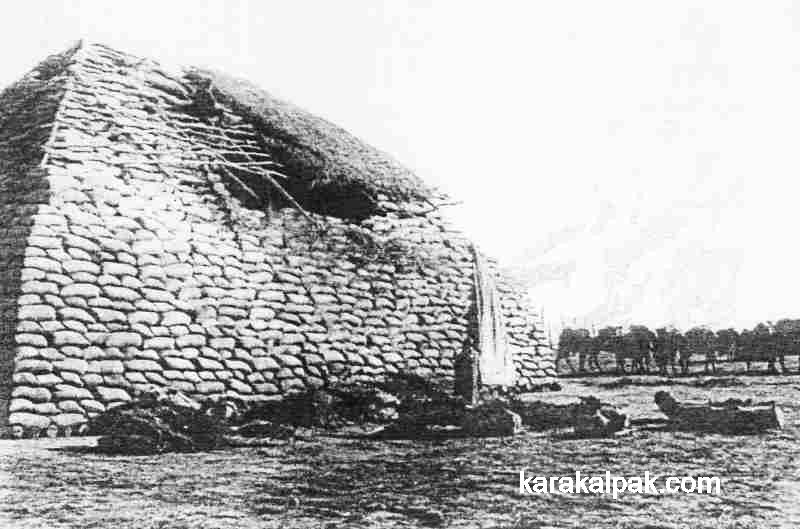
|
A stack of rotting cotton at Xojeli harbour, one of the consequences of collectivization.
Photographed by Ella Maillart in late 1932.
The bazaar at Taxta Ko'pir photographed by Ella Maillart in November 1932.
It has been said that the First Five Year Plan achieved one of the most precipitous declines of living standards in peacetime history. Although
Stalin was shaken by the national upheaval his policies had caused, he was unrepentant and publicly claimed his Plan had been a big success. At the
end of 1932 it was claimed that 99% of all Soviet industry was owned by the state and that 90% of the crop area was farmed by the collectives.
The Second Plan was purportedly aimed at the complete and final elimination of the remaining capitalist elements, emphasizing the need for quality
rather than quantity and on consolidating the improvements achieved so far. One of the successes of the Plan had been the establishment of universal
compulsory education and the development of a growing band of technicians and specialists. In the political field there was now an established system
of economic and political control, supported by a growing body of apparatchiks in the secret police, army, trade unions and Communist Party.
The period from 1934 to 1941 was one of consolidation for the totalitarian state, and began with a mass purge of the Party. The period was
characterized by accusations, arrests, show trials and confessions, some known to have been achieved through torture by the NKVD secret police. The
targets were senior party officials and old Bolsheviks, including the whole of Lenin's Politburo excepting, of course, Stalin himself. Many scholars
have attempted to rationalize the reasons for Stalin's terror campaign at that time he appeared to the outside world to be perfectly secure, since
most of his opponents had already been crushed and the Politburo was now solely composed of Stalin's own henchmen. Perhaps he was eliminating the
possibility of any future challenge - there were undoubtedly many dissenters throughout the Party, particularly following the disaster of the First
Plan. The elimination of a substantial proportion of the Soviet leadership certainly intimidated the rest and sent a clear message throughout the
USSR concerning the treatment of critics and dissenters. Within Central Asia many senior Communists were eliminated for failing to meet the
unrealistic objectives of the First Plan. Many more were branded "traitors" and "deviationists" during the later purges of 1937-38, including
Faizullah Khojaev, the Uzbek Prime Minister, and Akmal Ikram, the First Secretary of the Uzbek Communist Party, who were accused of a nationalist plot.
In the Turkmen SSR many thousands of Communist leaders were executed for nationalistic tendencies, including Kaikhaziz Atabayev, the Prime Minister,
Nedirbay Aytakov, Chairman of the Central Executive Committee, and Yakov Popok, First Secretary of the Turkmen Communist Party. From 1937 onwards
Kazalinsk on the Syr Darya became one of the places to which some of the luckier intellectuals were sent into exile. Until this so-called Great
Purge, many Communist leaders in Central Asia had been willing to allow the local people to continue enjoying many of their local customs. But now
such tolerance was dangerous.

|
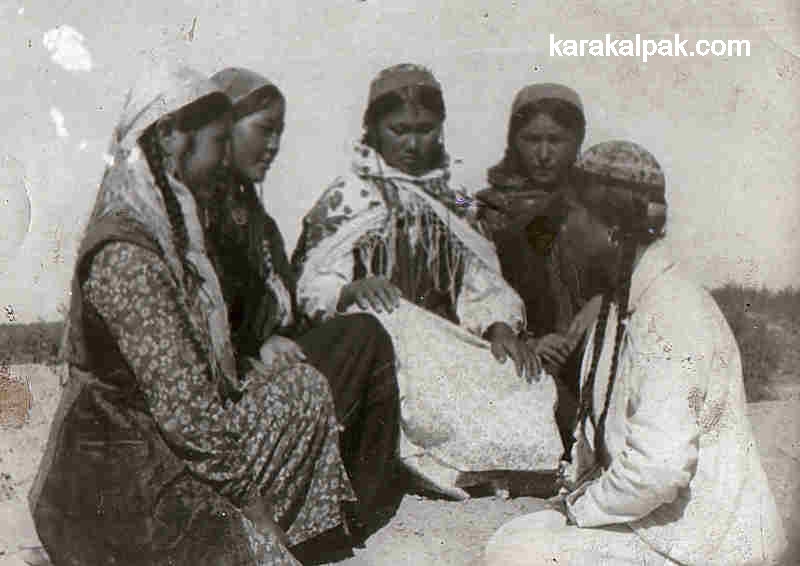
|
A woman and a group of young girls from the local Komsomol going to vote in 1938 at an election
at the kolxoz named after Kuybyshev in Shımbay region. Images courtesy of the Savitsky Museum, No'kis.
Karakalpak women checking the electoral register during elections, probably during the second half of the 1930s
The sign, written in Karakalpak Latin script, calls for full electoral participation. The photograph looks staged.
Image courtesy of the Regional Studies Museum, No'kis
In 1938 Moscow issued a decree requiring that the Russian language be taught in all non-Russian schools. This was associated with a second
"alphabetic revolution" with the introduction of a new Cyrillic alphabet. Its ultimate objective was to isolate the different Islamic populations,
especially those in Central Asia from foreign (Islamic) influences. This coincided with the introduction of national conscription.
Delegates to the Women's Congress, Karakalpakstan 1938. Photographer unknown.
By the end of the decade the USSR was becoming a significant industrial power. Some of the investment in industrialization had even reached Central
Asia, although most was concentrated around Tashkent and the Ferghana Valley. In Khorezm factories had been built for brickmaking, woodworking and
lucerne-processing in No'kis, a ship repair workshop was established at Xojeli, a power station and meat-packing plant appeared in To'rtku'l and the
fish and meat cannery opened in Moynaq in 1940. The capital of Karakalpakstan was relocated to No'kis in 1939 following the destruction of the
western part of To'rtku'l by the Amu Darya the previous year. In the Turkmen SSR the oil industry had been extensively redeveloped. Although
improvements in Soviet agriculture were slower to appear after the disastrous beginning, output from the collectives was rising and the irrigation
system had been partially extended. However the increasing focus on the production of cotton was the agricultural bright spot and the USSR had
finally achieved self-sufficiency, having become a net exporter of cotton in 1937. Much of this success was down to farmers in Uzbekistan, where
total cotton production had increased threefold, from ¾ million tonnes in 1934 to 2¼ million tonnes in 1940, thanks mainly to higher yields
achieved through the use of fertilizers. Similar levels of growth had probably been achieved in Khorezm over the same period, during which large
cotton-collecting depots had been opened in Xojeli, Shımbay and Qonırat. At the very end of 1939 a high level decision had been made to
expand cotton-growing in Uzbekistan even further. Various incentives were introduced to make this an attractive option.
The German assault on the USSR on 22 June 1941 came as a surprise to Stalin, despite having been pre-warned of the impending attack by the British.
The German blitzkrieg achieved rapid results - by mid-September the Germans had reached Leningrad and at the end of October the Ukraine was
overrun. The peasants of Belarus, Ukraine, and Greater Russia initially welcomed the Germans as liberators, but once the full savagery of the German
occupation became apparent, they soon changed their minds. Hitler's aim was nothing less than the total enslavement of the people and the creation
of a vast German colony in the East. Thanks to Hitler's overambitious tactics and an early Russian winter, the Nazi advanced stalled, and resumed
at a slower pace in the following spring. By August 1942 the Germans were advancing towards the heavily defended city of Stalingrad (modern Volgograd).
The battle for the city was fought street by street, factory by factory, and just when the Germans thought they had won, Stalin launched a brilliant
counter-offensive with secretly concealed reserve forces, isolating and capturing the German units. The tide had turned and throughout 1943 the Red
Army went on the offensive, supported by a surge in the production of armaments from Soviet factories. In July the Germans were defeated at Kursk in
the biggest tank battle in history, involving 6,000 tanks. Soviet forces crossed the Dnieper in the autumn, advancing through the Ukraine during the
winter. 1944 was the "year of ten victories", starting with the liberation of Leningrad. The Red Army, now numbering some 7 million soldiers, moved
on into Eastern Europe, while the Anglo-American second front opened up in France. Soon the race for Berlin was on.
The impact of the war on the Soviet Union was colossal. In very round terms the Americans lost 300,000 lives during the war, the British 400,000 and
the Germans an incredible 3 million. Soviet casualties were of an even higher magnitude military casualties have been put at between 9 and 11 million
and civilian casualties at a further 7 million!
Clearly the Great Patriotic War did not directly impact Khorezm, or Central Asia as a whole the Nazis never even reached the shores of the Caspian Sea.
Although many factories had been moved to Central Asia during the early years of the war, most had been located in the Tashkent area. However many
Khorezmians served in the Soviet armed forces, as witnessed by the memorials that stand today in every town and village across the region, from
To'rtku'l to U'shsay.
The Post-War Period
Following the elation of victory there were hopes in the Soviet Union of better times ahead and some easing of the pre-war restrictions. But a second
devastating major war in their lifetime had traumatized the old guard in a way that the West could not understand. Stalin admitted in public that he
was convinced there would be another war and this reinforced his paranoia about his countrys underlying industrial and military weaknesses. Stalin
was determined to embark on a massive programme of military expansion, including a crash atomic weapons programme, and needed to maintain the atmosphere
of fear and threat that motivated the war effort in order to rebuild and expand his industrial base. At home he tasked his close confidant Zhdanov to
initiate a reign of terror by means of a witch-hunt of "anti-Soviet" writers, artists, musicians, academics, and scientists, and focused his Fourth Five
Year Plan, covering the period 1946 to 1950, on restoring the colossal war damage and raising production back to and beyond 1940 levels. Relations
between the USSR and the Western Allies deteriorated quickly. Puppet Communist governments were installed across Eastern Europe while the US attempted
to rebuild Germany through the Marshall Plan. The Berlin blockade was followed by the creation of NATO and the test-firing of the first Soviet atomic
bomb at Semipalatinsk in eastern Kazakhstan. In 1949 Mao Zhedong and his communist supporters swept to power in China, and in the following year Stalin
finally approved Kim Il Sung's plan to invade South Korea. American and other Western forces were soon fighting Soviet, Korean, and later Chinese,
soldiers and airmen on the borders of Manchuria. The Cold War, which would poison world politics for nearly half a century, was well underway.
In 1946 agricultural policy had been placed in the hands of Andreyev, who cracked down on abuses of the collective farm system, preventing the
enlargement of private plots on kolxoz land and insisting that peasants fulfil their obligation to work their allotted number of days on the
collective (normally between 100 and 150 days a year for adults and 50 days a year for boys aged between 12 and 16). Kolxoz were frequently
established on existing villages, so there was a tendency for a clan or extended family to congregate in one farm and often enjoy a degree of autonomy.
Industrial workers faced new punishments for absenteeism and shirking. Monetary reform in 1947 required people to exchange 10 old roubles for one new
one, thereby wiping out any wartime savings.
By 1952 the economy of the USSR had expanded considerably, since 1928 - the year before the first Five-Year Plan industrial output had expanded
six-fold, and appropriations for the armed forces had expanded 26 times. Only a totalitarian state could have allocated resources to achieve such
tremendous increases. Yet this growth was accomplished without the usual associated benefit of a more prosperous labour force. Instead of rising,
people's incomes had actually fallen over the period in real terms the income of the average Soviet peasant or urban worker was 30 to 40% lower
over the period. The state had deliberately diverted resources from the people in order to amass the capital they needed to invest in industry, the
military, and government.
In Khorezm the situation may have been much better than in other rural areas of the USSR, thanks to cotton. Wages earned on cotton plantations were
much higher than those earned on cereal or livestock farms, although in the latter there was the opportunity to farm for oneself. In Khorezm the
acreage of cotton, which had declined during the War, began to increase again, motivated by highly favourable government procurement prices. However
the differential between farm and urban industrial wages was carefully controlled to ensure the increased demand for farm workers could be satisfied
and to prevent a drift from the countryside into cities like No'kis, Dashoguz, or Urgench. However in the early 1950s the highly attractive incentives
for planting cotton began to be withdrawn and in time cotton became less attractive to plant than grain. This resulted in a slowdown in the growth of
the cotton crop and a severe decline in peasant incomes in cotton-growing areas. It began to encourage migration from the countryside into the cities.
Stalin died in early 1953 following a stroke and during the long power struggle that followed, Nikita Khrushchev, a one-time shepherd, gradually emerged
as his successor. Formerly in charge of agriculture, Khrushchev had been a vocal critic of the grossly inefficient collective farm system and had only
recently launched his Virgin Lands campaign to plough up vast areas of Kazakhstan and southern Siberia in order to grow corn on more efficient
large-scale American-style farms. News of an investigation into the massive GULAG system was gradually leaking out to an appalled public and Khrushchev
decided to reinforce his position by denouncing Stalin's crimes and failures at a secret session of the XX Party Conference in 1956. As the revelations
became public there was a reaction against "Stalinism" and some liberalization of the system, including some easing of the controls and punishments
applied to workers. But the relaxation only encouraged uprisings in Poland and Hungary, which in turn inspired a Politburo challenge to Khrushchev's
leadership. Khrushchev cleverly turned the tables on his opponents and after a subsequent political purge he renewed his grip on power.
The decade of the 1950s was a time for big thinking and big projects. Work had begun on the Qara Qum Canal through Turkmenistan in 1947 and, when it
opened in 1956, it siphoned off one-third of the water flow from the Amu Darya, just by the Afghan border, and channelled it 1,300 km to Ashgabat and
beyond. This diversion would have serious consequences for the Aral Sea. An even bigger project to irrigate the central Qara Qum via the Turkmen Canal
was announced earlier in 1950. This was to run from the Amu Darya at Taqıyatas, just south of No'kis, to Krasnovodsk (present day Turkmenbashi) on the
shores of the Caspian Sea. The Taqıyatas feeder canal was opened in 1953, but then the project seems to have disappeared from sight without any
explanation. Had it proceeded it would have restored the agricultural lands in south-western Khorezm that had been swallowed up by the Qara Qum after
the Mongol invasion. The construction of smaller canals became increasingly mechanized, but the neglect of adequate drainage meant that more land was
abandoned through salinization than was brought into cultivation by new irrigation. The Uzbek chemical industry, initially heavily focused on fertilizer
production, was expanded and broadened. Cotton yields were improved further by the increasing availability of pesticides such as Aldrin, BHC and DDT.
In the late 1950s work was completed on the Amu Darya Valley railway project, linking Qonırat with Charjou and allowing Khorezmian cotton to be shipped
cheaply to Tashkent and beyond.
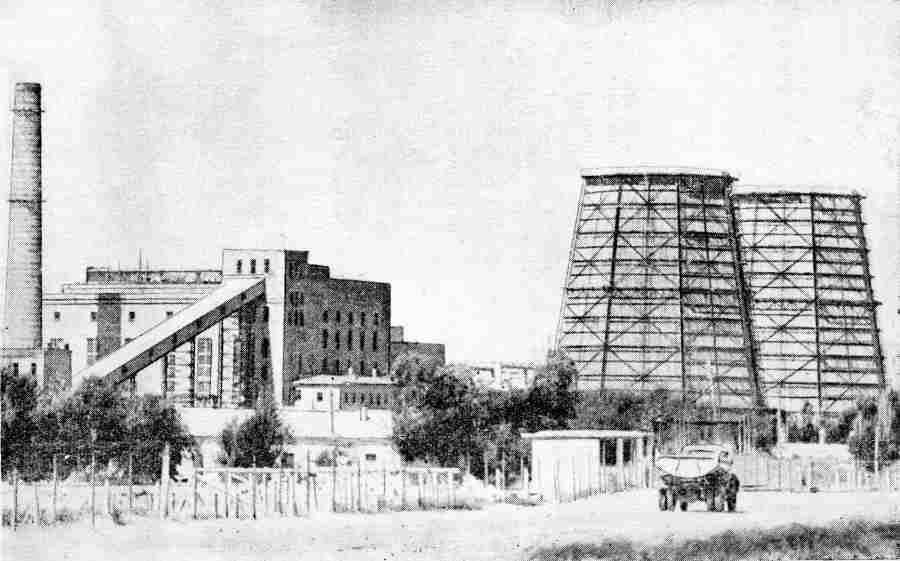
|
Taqıyatas power station, opened in about 1957.
It was a good time for agriculture in Khorezm despite being tough for agricultural workers. Cotton production was now almost 50% higher than its
level prior to the outbreak of war, boosted by increased mechanization and a growing irrigation network. Moynaq was then located on the offshore island
of Tokmak Ata and fishermen reached the fishing port by rowing boat. Some 3,000 fishermen were working the rich waters of the Aral Sea, catching carp,
bream, pike, roach, barbel, and a local variety of sturgeon. The record catch was in 1957 when 26,000 tonnes of fish were landed. Moynaq had a large
fish-cannery as well as a fur-farm, breeding sable, mink, and fox for hats and clothing. The southern coast of the Aral Sea supported a large dairy
industry, with cattle grazing on well-watered reed-beds and pasturelands. There was a passenger port with a passenger ferry to Ostrov-Aralsk (Aralsk
Island) and a cargo port at U'shsay. When the railway line finally reached Moynaq in 1953 it became possible to tranship Khorezmian cotton across the
Aral Sea to Aralsk, where it could continue its journey by rail into Russia. In addition to cotton the ferry also carried cargoes of wheat, sugar,
charcoal, fertilizer, and machinery. The coastline next to Moynaq had even become a popular holiday resort, with Communist bureaucrats flying in to
the town's small airport with their families and children being sent to summer camps by train. The Aral Sea offered pristine beaches and its air and
water were said to have healing properties for skin and respiratory complaints. Little did these holidaymakers realize the horrors taking place on the
island just over the horizon.
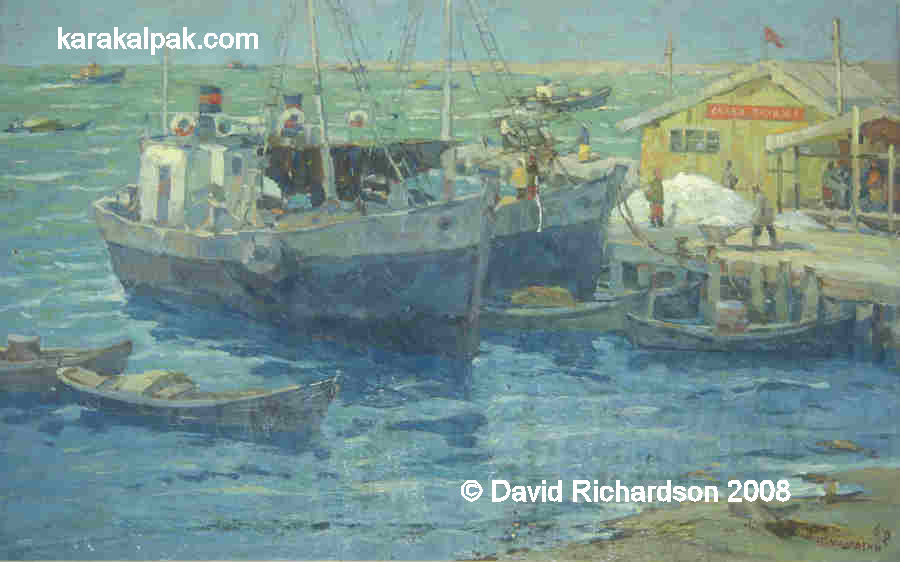
|
A painting of fishing boats at the port of Moynaq in the 1950s.
Image courtesy of the Local Studies Museum, Moynaq.
Soviet military advances had become substantial, based on a massive weapons development programme. Much of this had taken place in the so-called
"closed cities" or ZATOs, secret cities devoted to weapons design and manufacture, many of which were initially built by slave labour from the GULAG
camps. However these weapons programmes required secret test-sites that were remote and inaccessible. The immense wilderness surrounding the Aral Sea
was a perfect location. The launch of the two Sputnik satellites at the end of 1957 demonstrated early on that the USSR was already overtaking America
in some rather crucial areas. These missions were launched from a secret rocket test-site, codenamed NIIP-5, that had only just been constructed at
the Tyuratam junction on the right bank of the Syr Darya, close to Leninsk in the Qazaq SSR. In time the site became known as Baykonur or "Space
City", and Leninsk itself was eventually officially renamed Baykonur by President Yeltsin. Now vastly expanded and covering almost 100 kilometres of
steppe to the north of Baykonur city, it remains Russia's most important space centre.
There are numerous references to the Ustyurt being used as an atomic bomb test-site, some even identifying it as the location of the first Soviet atom
bomb test. One even refers to an underwater atomic explosion in the Aral Sea in 1955, well before either the US or the USSR began underwater nuclear
testing. These reports are all incorrect. One reason for them may be the large number of rotting industrial structures that have been left along the
western edge of the Aral Sea, north of Cape Aktumsyk, although these are remnants left over from the construction of the gas pipeline. It is of course
quite probable that the Soviet authorities evaluated the Ustyurt and the Aral region as a possible test-site during the early days of their atomic
weapons programme. Fortunately for Khorezm they chose a location 2,000 km away, at Semipalatinsk in eastern Kazakhstan. It was here, rather than the
Ustyurt, that Stalin issued orders for the first Soviet atomic bomb to be exploded on 29 August 1949. Until the closure of the site by a newly
independent Kazakhstan in 1991, Semipalatinsk was the location for a further 455 overground and underground nuclear tests. The Ustyurt was eventually
used as a test-site for peaceful nuclear explosions, although this was later in 1970. Three underground nuclear bombs, ranging in strength from 30 to
85 kilotonnes, were exploded some 200km west of Jaslıq at the Say-Utes nuclear test site. The objective of two of these tests was to see if there was
a quick way of producing underground storage cavities for natural gas condensate, while the third was a seismology application being tested by the
Ministry of Geology.
The northern Aral region was used for another major and closely related military project: the Soviet nuclear ballistic missile programme. This was
centred on the missile testing range at Kapustin Yar, which was established in 1947 on the bank of the Volga near Astrakhan. Missiles were launched
into the upper atmosphere along a test range stretching eastwards across the top of the Aral Sea. The very first live testing of a Soviet thermonuclear
warhead took place on 2 February 1956 using an R-5M rocket. The missile exploded 1,200km downrange from the test site in the vicinity of the
town of Aralsk. Thanks to a fault in a heating element, the 70-kilotonne warhead produced only a 300 tonne explosion a complete damp squib by normal
hydrogen-bomb standards. By June of the same year the R-5M had gone into service to support the first Soviet ballistic missile system. Over time
the Soviets developed a large facility for monitoring missile test launches, the ruins of which still remain today to the west of Aralsk.
Still remote, although much closer to Khorezm, the very different site of Aralsk-7 had been established on two Uzbek islands - Vozrozhdeniye and
Komsomolsk - in the middle of the Aral Sea in 1954, following a Soviet decision to resume biological weapons testing two years earlier. Although not
strictly a ZATO, Aralsk-7 was run by scientists but controlled by the military it had its own dedicated military detachment under the control of a
military base in Aralsk. The laboratory buildings and military barracks were constructed to the north of the island, along with accommodation, schools,
a cafeteria, and a power station. An airstrip on Barkhan Island provided plane and helicopter links to Aralsk, and a ferry ran to Aralsk and to
Udobnaya Bay on the eastern Tchink of the Ustyurt. The southern part of the island became an open-air test-site with an array of telegraph poles
spaced at one-kilometre intervals for testing the range and dispersal of infectious biological aerosols. The agents tested included anthrax,
brucellosis, bubonic plague, smallpox, and typhus. Experiments were not only conducted on laboratory mice and guinea pigs but also on sheep, donkeys,
horses, and monkeys. Their corpses were incinerated in a mobile autoclave. Tests were only conducted when the wind was blowing to the south away
from the research village and towards Khorezm! The island was protected from intruders by fast patrol boats. No'kis and the surrounding region were
already strictly off-limits to foreigners. The value of all of these Central Asian locations to the military authorities was their utter remoteness.
Even so high-flying Canberra and later U2 spy missions soon tracked down the existence and location of most of these top-secret sites, although the
details of their research programmes often remained hidden from the West.
It is remarkable to look back at the risks that the Soviet military were prepared to take with the lives of their citizens during this period. Various
incidents have been linked to the facility, including the contamination of Konstantin Island in 1960, the death of two Aral fishermen in 1972, huge
numbers of fish killed in the Aral Sea in 1976, and the death of half a million saiga deer on the Turgay steppes in 1988. One well-documented incident
has only recently come to light because of the release of an original report, covering the detailed investigation into an outbreak of smallpox in Aralsk
in 1971. The incident began with the infection of a young woman aboard a small fisheries research vessel, the "Lev Berg", which was on an extended
voyage circumnavigating the Aral Sea. She returned to the port of Aralsk with a mild fever, but soon returned to her home in Alma Ata (now Almaty),
Kazakhstan. After some time it became apparent that she and nine members of her family had contracted smallpox. Once her movements were known a
massive containment exercise was initiated. The town of Aralsk was sealed off and the railway station closed. A tent city was erected to quarantine
the 250 people most at risk and some 43,000 residents were inoculated. News of the incident was suppressed by the Soviet regime and even today, more
than thirty years later, the Russians remain coy over the details. Because a high proportion of the Aralsk smallpox infections were of the severe and
often fatal haemorrhagic variety, Western researchers have concluded that they were caused by a hardened and weaponized variety of the virus.
Given all of this secret military activity it is not surprising that the whole of Khorezm was a closed area for many decades, absolutely off-limits to
Western travellers. When the two Marxists, William and Zelda Coates, visited Uzbekistan in 1951, they claimed that they were free to travel anywhere,
yet it is interesting that they never got any further west than Samarkand. When the daring Scot, Fitzroy Maclean, was sent to Moscow as a junior
British diplomat in the years just before the Second World War, he managed to smuggle himself into the forbidden territories of Central Asia and even
to visit Bukhara, evading his NKVD followers by day and sleeping in the gardens of a mosque at night. When he returned as a knighted war hero and
ex-government minister in 1958, he found that he was now welcome in Tashkent and Samarkand, but that a visit to Bukhara was still totally out of the
question, even for him. Refusing to take no for an answer he did eventually manage to get to that city, but only after meeting Khrushchev face to face
at a diplomatic reception in Moscow and asking for his specific permission to go!
Khrushchev initiated many reforms in agriculture and education, allowed Solzhenitsyn to publish his novel on life in the GULAGs, and was the first Soviet
leader to travel to Western Europe and the USA. This had several repercussions within Khorezm. In the academic field a Karakalpak branch of the
Academy of Sciences of Uzbekistan opened in No'kis in 1959.
One aspect of the more relaxed political atmosphere created by Khrushchev was that an increasing number of Uzbeks began joining the local Communist
Party and, providing they abandoned their Uzbek lifestyle in favour of a Russian lifestyle, began to find their loyalty rewarded with positions
in government. In 1959 Sharif Rashidov, a native Uzbek from the Jizzax region of Samarkand Oblast became First Party Secretary of the Uzbek
SSR. Rashidov's term was to last until 1983 the longest duration of any term of office for a communist leader of Uzbekistan. Rashidov was a
soft-spoken sybarite with pretensions of becoming a novelist, but had ambitions that Uzbekistan should be ruled less by Moscow apparatchiks
and more by local politicians. However first he had to overcome the internal strife raging between the powerful elite within the Uzbek Party.
Depths of the Cold War
On the international scene hopes of détente proved to be short-lived. Relations with the US worsened following the shooting-down of a U2 spy
plane and the construction of the Berlin Wall in 1961. By now the USSR was a military superpower and had even put the first men into space. But when
Khrushchev misjudged Kennedy over the Cuban Missile Crisis he had to make an embarrassing climb-down. Domestically the failure of his agricultural
policies, including the Virgin Lands initiative, led to food shortages. A bad harvest in 1963 led to the disgrace of having to import foreign grain.
Khrushchev knew that his enemies, led by the cowardly Brezhnev, had had enough. While he was enjoying his holiday in the Crimea during the following
year, he was summoned back to Moscow for an extraordinary session of the Central Committee. He accepted the option of resigning "on grounds of ill
health" rather than face a trial for the mismanagement of state affairs.
During the Brezhnev years the Soviet Union reached its pinnacle, but also commenced its decline. The uninspiring Brezhnev and his cohorts were
old-timers and their natural instinct was to re-establish firm control. However the spark of liberalization had been lit and over the coming years
dissent would arise in many quarters, albeit at a low level from intellectuals, ethnic minorities, and religious believers. The first international
challenge was the "Prague Spring", which led to a predictable Soviet intervention and the toppling of Dubĉek in Czechoslovakia. But there were
also sensible reforms a move towards better management and financially based decision-making in commercial enterprises and a greater focus on the
production of consumer goods. In 1969 the Strategic Arms Limitation Talks got underway, leading to a nuclear non-proliferation treaty in 1971, the
same year that Nixon made his groundbreaking trip to Beijing.
The former campaigns against Islam and local ethnic cultures had meant that many of the historical ancient monuments throughout Central Asia had fallen
into serious decay and attempts at restoration began during the 1950s. For example in 1952 a team of archaeologists and architects was put together
to research and survey the monumental buildings in Khiva and to plan their restoration. One positive civic development was the formation of a Soviet
Society for the Preservation of Ancient Monuments in 1966, which led to the Ichan qala being declared an open-air museum in the following year. Sadly
this involved most of the inhabitants being evicted from their homes, turning the ancient citadel into something of a ghost city. However all of
Khorezm was still off-limits to any foreigners visiting the USSR. Modern visitors to Central Asia sometimes criticize the over-restoration of its
historical buildings, but are unaware of the dreadful state of decay that some of them had fallen into, as evidenced by some of the pre- and post-war
photographs.
There were now increasing concerns over the availability of water and of environmental degradation in the regions irrigated by the Amu Darya and Syr
Darya. Cotton requires much more water than other crops, and the massive irrigation network that had been built throughout Khorezm was inefficient,
leading to enormous wastage. Projects like the Qara Qum Canal coupled with increasing consumption of water upstream meant that the flow of both rivers
into the Aral Sea was much reduced. More alarming still was the decline in the level of the Aral Sea that had begun from about 1960 onwards. At first
the decline was small, because of compensation from the draining of the lakes within the delta and releases from the surrounding water table. Some of
the first people to recognize the problem were the Aral fishermen, who noticed the level of the highest tide falling relentlessly from 1964 onwards.
Soon the port at Moynaq began to dry up and Tokmak Ata Island gradually became connected to the mainland. At first they were forced to relocate their
boats from the fishing port to the cargo port at U'shsay. But in time this also began to run dry and channels had to be cut to allow the boats to reach
the Sea. It was an impossible battle and eventually the ferry service was terminated and the bigger fishing boats were left stranded on the dried-up
seabed. The rusting hulks that remain today in the so-called "ships' graveyards" at Moynaq, U'shsay, and Aralsk are only a fraction of the original
fleet, many of which were subsequently dismantled for scrap.
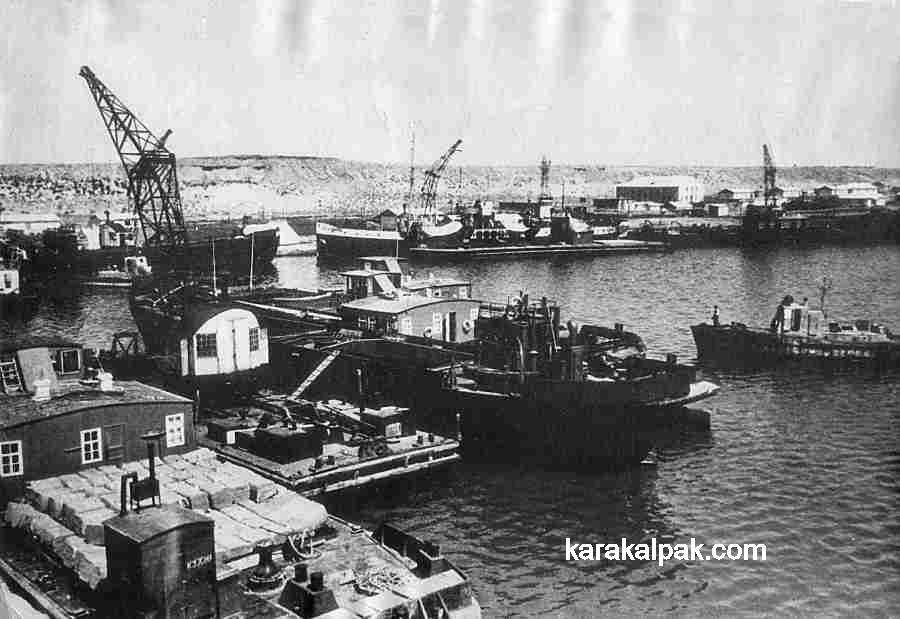
|
Boats at the port of U'shsay at some time prior to 1967.
Image courtesy of the Regional Studies Museum, No'kis.
By 1970 the shoreline had receded by about 10 km, leaving the community of Moynaq stranded and its former fishermen unemployed. The small town of
U'shsay that was once home to one thousand fishing families had lost its livelihood and would gradually decay into the ghost town that we see today.
Remarkably the fish-cannery at Moynaq continued to soldier on by processing local freshwater lake fish and bringing in frozen fish by train from the
Caspian and the Barents Sea! Fishing continued for a while from the small villages to the west of Aralsk, like Dzhambul, but these too had given up
by 1975. Within the delta the most vulnerable agricultural communities were ordered to relocate to new areas. The large village of Ourga was
completely evacuated and moved to the Qonırat district during the mid 1960s. Worse was yet to come.
Fishing boats at Axantai Lake to the south of the Aral Sea around 1980.
The response of Minvodkhoz, the Ministry that had been established in 1965 to take responsibility for irrigation and canals, was to obtain authorization
for a massive canal project, termed "Sibaral", to bring water from southern Siberia into the Aral basin. Such massive long-distance projects seemed
to be an endemic feature of Soviet economic planning. The Gazli-Urals gas pipeline had only recently been commissioned to transport natural gas from
the Gazli wellhead in the Qizil Qum, through Khorezm, north along the edge of the Ustyurt next to the Aral Sea, and across the Orenburg steppes to
supply the towns of the southern Urals. It was the longest pipeline in the USSR. Another transport link completed in 1972 was the extension of the
railway line from Qonırat across the southern Ustyurt to Beyneu, following the line of the ancient caravan route. This linked Khorezm to the line
from Aktau on the Mangishlaq Peninsula to Orsk in Russia, providing an alternative to the Aral ferry and allowing goods to be transported to Russia
without going via Tashkent.
The remoteness and isolation of Khorezm was responsible for another amazing development the creation of a gallery of avant-garde Soviet art in No'kis
as the result of the energy of just a single extraordinary man, Igor Vitalyevich Savitsky. Savitsky was a Ukrainian artist who had been invited to
come to Khorezm by the ethnographer Tatyana Zhdanko, whose sister happened to be to the wife of the artist with whom he had trained in Moscow. Savitsky
had experienced his first taste of Central Asia in Samarkand, where he had been evacuated during the war. Now he became a junior member of the
pioneering Khorezm Archaeological and Ethnographical Expedition under the charismatic leadership of Sergey Tolstov, responsible for the illustration
of archaeological sites. He became smitten with Karakalpakstan and by about 1957 started to build up a collection of local ethnographic folk art,
especially embroidered costumes, jewellery, and yurt decorations. At the same time he began to collect paintings, not just from Central
Asian artists but from important Russian painters as well, often travelling to Moscow and Saint Petersburg by train to collect works from struggling
artists or their widows. Savitsky even charmed the local authorities in No'kis to build a local Museum of Art and in 1966 he was installed as its first
director. This was dangerous work, punishable by detention in a work camp had he been exposed to the powers that ruled in Moscow. In 1962 Khrushchev
had reacted to an exhibition of abstract art in Moscow by exclaiming: "The people and government have taken a lot of trouble with you, and you pay them
back with this shit!" Twelve years later bulldozers were used to destroy an exhibition of modern art in the same city. Fortunately for Savitsky his
endeavours were never exposed to major political criticism and his marvellous collection remains in No'kis to this day. How he got away with it still
remains a mystery. Today increasing numbers of Western art lovers are making the pilgrimage to see it.
The objective of Brezhnev's 1971-75 Plan was to achieve a substantial increase in people's material and cultural living standards and to invest heavily
in agriculture. Like most Plans this fell far short of its targets, but life was gradually improving for many Soviet citizens. Blocks of modern
apartments began to spring up in urban centres like Urgench and No'kis and the very first televisions, refrigerators, and cars were becoming available.
Even today local people look back at the Brezhnev period as the time when there was no shortage of jobs, earnings were sufficient to cover most peoples
basic material and cultural needs, and there was a comprehensive infrastructure of services and support for housing, transport, education, medicine, and
social benefits. Internationally too the Soviet Union was feeling more confident and more assertive - Soviet military power was essentially on a par
with that of the USA. The USA meanwhile was internally wracked over the Vietnam War and the Watergate scandal and in 1975 the Viet Cong finally
overran South Vietnam.

|
Plans for Lenin Square in the centre of No'kis during the 1970s.
Building new apartment blocks in No'kis at some time around 1980.
By the early 1970s Sharif Rashidov was well-established as First Secretary, seen in the Kremlin as a devoted supporter of Brezhnev. Meanwhile back
in Tashkent, Rashidov was steadily transforming the Uzbek Communist Party and government into his own personal mafia organization, ruled by members of
his own clan and held together by a massive system of patronage. He had systematically begun to infiltrate his relatives and friends into important
government positions, which they then came to regard as fiefdoms for their own personal enrichment. Rashidov had one son and four daughters. Two of
his daughters married important sons belonging to the Muminov clan, who controlled the Samarkand and Bukhara regions. His son was married to a daughter
of Qa'llibek Kamalov, the First Secretary of the Karakalpak Communist Party for 21 years from March 1963 to August 1984. As such Rashidov maintained a
firm grip of Karakalpak affairs.
By 1971 Rashidov had finally succeeded in filling the chairmanship of the Council of Ministers and the Presidium of the Uzbek Supreme Soviet with his
own followers. Now Rashidov and his henchmen began to exploit the Soviet planning and production system for their own ends. Every year Uzbekistan
received income for its cotton harvest from Moscow, based on the gross weight of raw cotton produced. In reality the harvest always fell short of the
Five Year Plan target, but officials would boost the reported harvest through a variety of means: from simple "report padding" to overstating the
moisture or stone content of the cotton. Through such simple false accounting Rashidov and his accomplices embezzled vast sums of money throughout
the 1970s and early 1980s, variously claimed to be of the order of from $2 to $10 billion! How such a massive fraud was concealed for so
long is in itself an amazing question, especially when cotton output was reportedly rising steadily while fabric production was declining. One answer
is that Rashidov had systematically bribed senior officials in the USSR Ministry of Internal Affairs in Moscow, one of them being Brezhnev's own
son-in-law. Brezhnev himself never saw through the scam and continually pressed Rashidov to achieve better and better results!
Rashidov's period of office was not only associated with fraud. Drugs, prostitution, gambling, and murder for hire were all rackets that thrived within
his regime, in true mafia tradition.
Although 1978 was a record agricultural harvest for the Soviet Union as a whole, it was also the beginning of economic stagnation. There had already
been some worrying signs, with a crop failure in 1972 relieved by the purchase of American wheat and an even worse crop failure in 1975. Now there
were a succession of harvest failures in 1979, 1980, 1981 and 1982. Despite the greatest agricultural land resources in the world, it was gradually dawning
on the USSR that it could not feed itself. The pigeons were coming home to roost - lack of enterprise, bad management, corruption, low morale,
inflexibility, poor quality and maintenance, inappropriate investment were all conspiring to produce declining productivity.
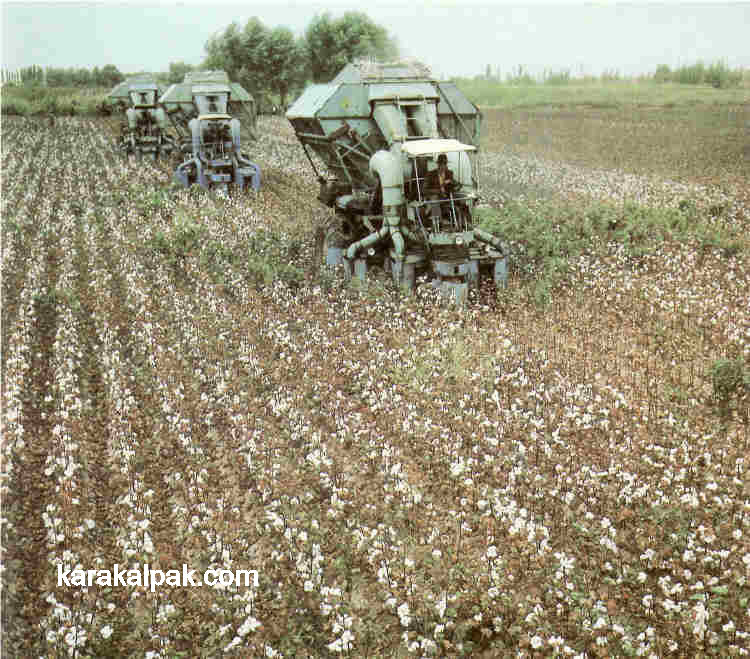
|
Machine-harvesting Karakalpak cotton.
Officials inspecting the cotton crop in the early 1980s.
In Khorezm the failure to address the problem of soil salinization was leading to depressed cotton yields, the response to which was the use of more
and more fertilizers and pesticides. Uzbekistan boasted that it used 2¼ times as much mineral fertilizer per hectare than the developed West.
But increasing chemical use in the 1960s and 1970s was leading to the build-up of harmful pesticide and nitrate residues in the soil and ground water.
Another damaging development had been the introduction of defoliants, which accelerated the opening of the cotton boll and assisted in its mechanized
harvesting. The most common defoliant was Butifos, an organo-phosphate chemical that left behind a nauseating stench in the fields and villages.
Butifos had been recommended for use by the Soviet authorities as early as 1964 and by 1984 was being used on about 70% of the Uzbek cotton crop.
The other main defoliant was 2,4,5-T, a component of Agent Orange, used in Vietnam. Both would leave a toxic legacy in the soil for decades, or perhaps
even centuries. Meanwhile the Amu and Syr Darya deltas were continuing to dry out. In the mid 1970s huge dams were built upstream from To'rtku'l
at Tu'yemoyın on the Amu Darya and at Chardara on the Syr Darya, designed to store sufficient water to compensate for a year of poor water flow. More
hydroelectric dams were built upstream, creating more water reservoirs such as the Toktogul reservoir on the Naryn. From this time onwards the
already declining natural flows into the Aral Sea began to fall dramatically. By 1980 most of the hundreds of freshwater lakes across northern
Khorezm had disappeared.
On the international scene Brezhnev now made a terrible miscalculation - sending Soviet tanks south through Uzbekistan and across the Friendship
Bridge spanning the Amu Darya into Afghanistan. Jimmy Carter retaliated by imposing a grain embargo and a boycott of the Moscow Olympic Games. To
make matters worse, NATO decided to deploy cruise and Pershing missiles in response to the Soviet deployment of SS-20 ballistic missiles. Next the
anti-Soviet Reagan administration upped the ante and embarked on a new arms race. The Cold War was about to enter its final phase.
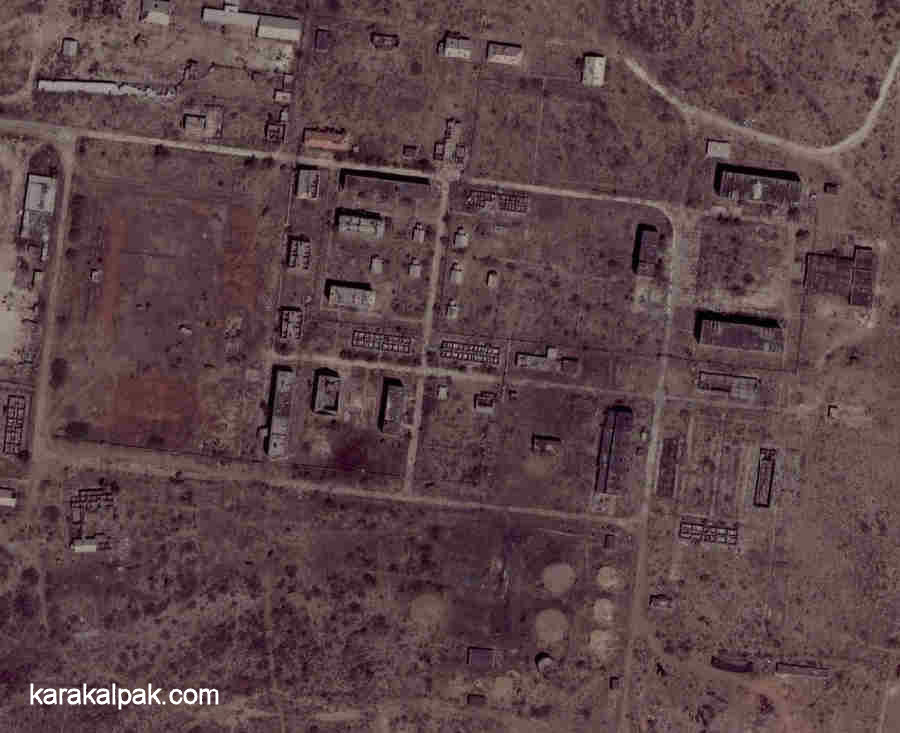
|
Satellite image of the deserted biological weapons complex of Aralsk-7 on Vozrozhdeniye Island.
Image courtesy of Google Earth.
Khorezm was given its own part to play in the arms race. In 1973 the USSR, USA and UK signed the Biological and Toxic Weapons Convention, agreeing
never to develop, produce or stockpile biological weapons and to destroy all existing stocks. However the Convention failed to include any mechanism
for verification. Fearing that the USA would continue its own programme in secret, the Soviets decided to maintain a covert programme operated by
Biopreparat, established as a pharmaceutical cover operation. The totally isolated facility on Vozrozhdeniye Island suddenly became an extremely
valuable asset. The laboratory complex was expanded to eventually accommodate over one thousand scientists, who lived on the island with their
families. One enterprising journalist researching this site recently tracked down some of the people who once worked on the island. They recalled
its idyllic setting in the middle of the Aral Sea, and how they spent their free time painting and sketching! However their daytime jobs were not
so pleasant. They worked on the development of strains of anthrax, bubonic plague, and smallpox that were super-resistant to antibiotics and then
tested them on animals before they were "weaponized" for use in ballistic missiles. Details of the nature and scale of the Soviet programme caused a
massive shock in the West when they were made public following the defection of Kanatjan Alibekov, the Qazaq First Deputy Director of Biopreparat,
to the USA in 1992. Now a US citizen, Ken Alibek - as he is now known - has testified that testing on Vozrozhdeniye only took place at night, to
avoid US satellite detection. Soviet scientists positioned caged monkeys on pylons across the test-site before firing bomblets overhead, which
released their deadly contents for dispersal downwind. Hundreds of monkeys were horrifically poisoned with these appalling materials every year.
Chemical weapons were not covered by the Biological Weapons Convention, and during the 1960s and 1970s, the USSR had secretly built up the largest
arsenal of chemical weapons on the planet. Formal negotiations on a chemical weapons ban only started in 1980 and were to last until 1992. During
the early 1980s the Soviet military began work on a new type of highly lethal binary chemical weapon called "Novichok", meaning "new guy", at a
highly secret chemical weapons research institute in No'kis. This new gas was purported to be five to eight times more toxic than VX nerve gas. Tests
were conducted over an enormous area of the Ustyurt, from east of Jaslıq to the centre and north of the plateau, under the pretext of a project to
develop smoke bombs. At one time 300 scientists were involved in the programme. Many thousands of saiga and other animals were gassed inadvertently
as a result of these tests.
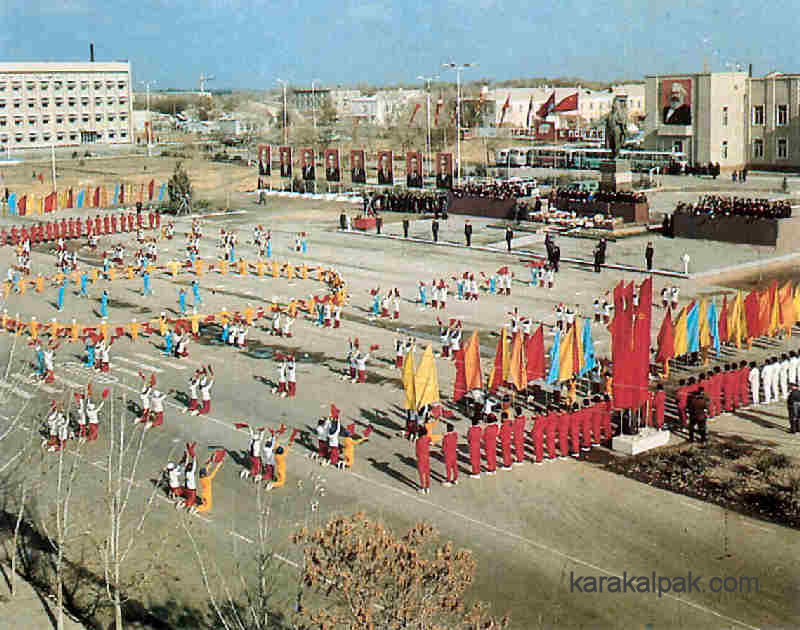
|
Official Soviet celebrations in Lenin Square, No'kis.
Officials being welcomed with flowers at an official Soviet Bayram.
In front of the Lenin Monument in Lenin Square, No'kis, in the early 1980s.
After several years of failing health and with his grip on affairs faltering, Brezhnev died in late 1982. Even in government many people believed
the system had become paralyzed. There was a crying need for younger and more energetic leaders with new ideas. But the average age of the Party
leadership was now over 69 and their imaginations could only stretch to electing a 68-year old hard-liner suffering from kidney disease. Yuri Andropov
had been the former head of the KGB and acted swiftly and predictably to attack inefficiency, absenteeism and corruption, even tasking the militsia
to check shops and cinemas to see if people were avoiding work. He believed that socialism would develop more swiftly if corruption and fraud were
exposed.
Two of his prime targets were Uzbekistan and the Ministry of Internal Affairs in Moscow. The Internal Affairs Minister, who had been on Rashidov's
payroll, was dismissed and the KGB was sent in to investigate. Rashidov was able to slow down the investigation in Tashkent by removing senior members
of the Uzbek KGB. Despite these delaying tactics Andropov succeeded in uncovering the scandal. During 1983 Andropov sent the Chairman of the
Azerbaijan KGB on a mission from Moscow to visit Sharif Rashidov in Tashkent with a tacit message that the game was up. The following day Rashidov
was dead, presumed to have committed suicide. Yet this was still not the end of the fraud. At Rashidov's lavish funeral in Tashkent his successor,
Inamjan Usmankhodjaev, foolishly vowed to keep Rashidov's promise of producing 6 million tonnes of cotton that year. He was only able to achieve that
target by ordering the Chairman of the Uzbek Council of Ministers to falsely inflate the production figures by another 240,000 tonnes!
In June 1983 Andropov was elevated to become Chairman of the Presidium of the Supreme Soviet, essentially "president" of the USSR, but within months
he was dead. As if things could not get even worse, he was succeeded by the 72-year old Konstantin Chernenko, a life-long bureaucrat who became
affectionately known as "the living corpse". He would survive for just over a year.
The Collapse of Communism
On 11 March 1985 the day after Chernenko's death, Mikhail Gorbachev was selected by a narrow margin as the new General Secretary by the Politburo.
He was a younger man who had risen rapidly through the ranks and had been schooled by Andropov in the KGB. He was well aware of the massive problems
facing the USSR, including its poor living standards compared to the West, and had expressed his views to his associate Eduard Schevardnadze that
"Everything is rotten through and through". Not only had economic growth been brought to a halt as the regime had tried to keep up in the renewed
arms race, but nothing worked anymore, morale was at rock-bottom and a sickness seemed to pervade the whole of society. One third of all trucks were
out of service at any one time. The annual number of abortions was twice the number of live births. The divorce rate was over 50% and alcoholism
was rife. Internationally relations between the US and the USSR were at an all-time low. Soon Chernobyl would highlight the collapse of Soviet
industry.
Yet Gorbachev remained a committed Communist, and believed that the Soviet system simply needed to be modernized to make it work. His cry was for
glasnost (openness) and perestroika (restructuring). But he faced insurmountable inertia. An early attempt to reduce vodka
consumption failed miserably. Having called for radical reform at the XXVII Party Conference, Gorbachev tried to shake up the economy and reduce
the black market by passing laws that legalized private work. But this made it taxable so it remained a part of the black economy. A new law on
cooperatives was more successful for a while, allowing people to operate their own businesses and become employers. A few years later he proposed
that peasants should become masters of the land again and laws were changed to allow them to lease their own land, although few took up the opportunity.
In Central Asia Gorbachev was determined to clear out the corrupt and well-entrenched cliques that ruled the five Republics and to replace them with
men he could trust. Within weeks he appointed Saparmurat Niyazov as Prime Minister of Turkmenistan, chosen because he was known in Moscow, was a
member of the dominant Tekke tribe and, as an orphan, had no associations with any powerful family group. In December Niyazov was also made First
Secretary of the Turkmen Communist Party, replacing its fifteen-year incumbent Gapurov. Radical purges of the regimes in Kyrgyzstan, Tajikistan, and
to a lesser extent Kazakhstan, also took place at the turn of the year.
However the prime target of Gorbachev's anti-corruption campaign was the Uzbek leadership, given their lack of action to resolve the "Uzbek Matter".
A massive purge of the Uzbek regime began in 1985 - thousands of officials were arrested and 18,000 were expelled from the Party. Corruption trials
began in Tashkent with prosecutors brought in from Moscow. However many more members of Rashidov's mafia kept quiet and remained in their jobs,
protected by a code of secrecy. In true Soviet style the investigation gradually lost momentum as crucial evidence was lost and prosecutors were
stopped as they got close to leading officials in the Kremlin. Although Rashidov had escaped the purge, within Uzbekistan he was regarded as a hero
for outsmarting the Russians over Uzbek cotton. In a bizarre twist the aggressiveness of the purge turned many Uzbek politicians against Moscow and
fostered resentment concerning the past emphasis on cotton and the attempts to subvert Islam.
Although his new ideas were making little impact on the economy, Gorbachev's message of openness increasingly encouraged people to express their views
in newspapers, radio broadcasts, and on TV. The grim reality of daily life was fully revealed and criticisms of the regime were aired openly. People
were exposed to previously banned publications and to Western news and entertainment. The genie was out of the bottle. In Central Asia people began
to feel more confident about expressing their Muslim beliefs and men with beards and women with headscarves were seen on the street. One consequence
of Chernobyl and the new openness was that environmental issues began to get aired, including the Aral Sea disaster, which came to symbolize the folly
of centralized Moscow-based planning. By now all the commercial fish stocks in the Aral Sea had been eliminated, the fishing industry at Moynaq had
closed in 1983 and the falling water table was destroying the agricultural oasis in the northern delta. Interestingly one of the first projects canned
by Gorbachev after his appointment was the Sibaral canal.
Internationally Gorbachev had made an early impact on both Margaret Thatcher and Ronald Reagan and in time this had paid off, with important INF missile
reduction and verification agreements signed in 1987 and 1988. Soon Soviet troops would be withdrawing from Afghanistan. But openness had its downside
too - unrest was simmering in the non-Russian Republics such as Kazakhstan, Georgia, Armenia, Azerbaijan, and the Baltic States.
Many traditionalists and apparatchiks, who benefited from the status quo, were strongly opposed to the reforms and the relaxation of controls
gave the appearance of increasing anarchy. This was even true in Central Asia where leaders like Niyazov loyally carried out instructions from Moscow,
but without any great enthusiasm. Indeed many traditionalists like Annamurad Khodzhamuradov, appointed Turkmen Prime Minister in 1986, could not
swallow Gorbachev's new ideas at all. Gorbachev was also facing criticism that his reforms were not achieving improvements, one of his sterner critics
being the highly popular Boris Yeltsin who wanted a completely new system, with multiparty democracy and a market economy.
Frustrated with the gradual pace of change in Tashkent, Gorbachev replaced the First Secretary to the Party with the pro-Moscow Rafik Nishanov in 1988,
but this increased resentment against Moscow even further. When ethnic tensions exploded between Uzbeks and Meskhetian Turks in the Ferghana Valley
the following year, Gorbachev decided it was time to ease the pressure. At the same time he needed to subvert the established Tashkent and Ferghana
regional loyalties that had controlled Uzbek politics since Rashidov's departure. So, in June 1989, Islam Karimov was appointed First Secretary of the
Central Committee of the Communist Party of Uzbekistan. Formerly a government technocrat he had been chosen by Moscow for three reasons: his tough
"iron fist" personality, the absence of any former association with corruption, and his background - he was half Uzbek and half Tajik and came from
Samarkand, so did not belong to the established Party elite. Yet ironically Karimov had actually been a protégé of Rashidov, a man he
secretly admired. Just like his predecessors Karimov soon surrounded himself with a coterie of trusted associates from his hometown. For the second
time since the formation of the Uzbek SSR, politicians from the Samarkand region were back in control of the nation.
As Karimov sidelined the powerful Tashkent elite he also had to build personal support elsewhere. He delegated some responsibility for managing the
cotton harvest to oblast leaders and brought other provincial leaders closer to the centre of affairs in Tashkent. Rather than continue with
the persecution of the wrongdoers, he actually rehabilitated those Samarkand and other politicians who had been targeted by prosecutors in Moscow.
However these were not the only changes occurring in Tashkent at this time. The new spirit of openness was not only fostering political debate but
was also encouraging the formation of the first opposition party since the Communists took control. Muhammad Salih, a 40-year-old Khorezmian writer
and poet, had formed Birlik Halk Harakiti (or Unity Popular Front) at the end of 1988. In addition to democracy and independence, Birlik
wanted to see the diversification of agriculture, a programme to save the Aral Sea, and Uzbek as the national language. The new party rapidly gained
supporters and not only forced Karimov's new regime to ban public meetings but also to introduce a number of liberal reforms. However its rapid
success soon led to problems when its supporters increasingly sought confrontation with the authorities on the streets. The disappointed Salih left
Birlik in early 1990 to form a splinter party known as the Erk (Freedom) Democratic Party, stressing independence first and democracy
later. The Islamic Rebirth Party or IRP was formed in the same year with the objective of forming a government ruled by an Islamic constitution.
The split in the opposition was good news for Karimov, who may well have played a hand in Salih's decision.
Meanwhile, in Turkmenistan, the opposition party Agzybirlik had been formed in 1989 and had held the countries first demonstration for decades
at the historical site of Geok-Tepe early in the following year. In 1991 the Turkmen Academy of Sciences formed Paikhas.
But things were moving much faster elsewhere - 1989 was the critical year when the whole Soviet bloc began to fall apart. First of all Communist Party
hard-liners were humiliatingly defeated in the elections for the Congress of People's Deputies. In Poland the rebel union Solidarity forced elections,
which the Communists embarrassingly lost. Lithuania, Estonia, and Latvia all declared their own sovereignty. As the year came to a close jubilant
crowds brought down the hated wall in Berlin, the Communist regimes in Czechoslovakia and Yugoslavia collapsed and rebellion in Romania was followed
by the execution of Ceauşescu and his wife. In the past Soviet tanks would have arrived to restore control, but fortunately that was not
Gorbachev's style. 1990 began with a huge demonstration in Moscow. In March the Congress of People's Deputies voted to end the Communist Party's control
over the government and elected Gorbachev executive President. In June the Russian parliament decided that Russian law would take precedence over
Soviet law.
In Tashkent Birlik was increasingly setting the political agenda, campaigning for increased acceptance of the Uzbek language and against
the poor treatment of Uzbek conscripts in the Soviet military. Moscow responded with a decree limiting the number of conscripts who would be assigned
to construction rather than regular units, while the Supreme Soviet decided that Uzbek would become the state language. In October Karimov exploited
the opportunities created by Gorbachev and Yeltsin by instructing the Uzbek Supreme Soviet to declare Uzbekistan a sovereign state ruled by Uzbek law,
and to elect him to the newly created position of President of Uzbekistan. Turkmenistan had already declared its sovereignty in August and Niyazov
followed suit by creating the position of President for himself at the end of October.
At the annual Party Conference in Moscow there was disarray, with Yeltsin resigning from the Party. It was announced that a large proportion of State
enterprises were to be privatized and loss-making collectives would be turned over to the peasants. But the economy was faltering, prices were rising,
there were food shortages, the mafia were rife and people were scared and angry. Gorbachev needed to counter the pressure building up in some of the
Republics for autonomy and appealed directly to the people for support for a renegotiated Union Treaty in a Union-wide referendum in March 1991. The
most aggressive Republics refused to participate, the Ukraine was divided, but a majority in Russia and Belarus still wanted to retain the Union.
In conservative Central Asia the vote was an amazing 90% in favour of remaining within the USSR (98% in Turkmenistan!). But then in June
Gorbachev suffered a major embarrassment. The highly popular Boris Yeltsin was swept to power as President of the Russian Republic and immediately
disqualified the Communist Party from work in all Russian state organizations.
The leaders of the Central Asian Republics had loyally supported Gorbachev on the Supreme Soviet in the face of the troublesome Yeltsin. They now
responded to their citizens overwhelming support for the Union by demanding increased control over their own economies. In one final attempt to keep
the Soviet Union together Gorbachev decided to rewrite the Union Treaty, offering all of the Republics a much greater degree of autonomy, including
the right to determine exactly how much authority to transfer back to Moscow. After Gorbachev's closest advisors read the draft they were reeling.
The hard-liners decided that enough was enough. While Gorbachev was holidaying at his dacha on the coast in the Crimea, they struck. KGB guards
cut his phone lines and held him under guard. The following day a state of emergency was imposed across the USSR. Interestingly Karimov endorsed
the coup, but Niyazov remained neutral. In Moscow Yeltsin immediately realized the danger and managed to get to the White House, the Russian parliament
building. He appeared on international TV, standing on the top of a tank, defiantly opposing the coup leaders. The news spread quickly and he was soon
joined by tens of thousands of enthusiastic supporters who created a human barricade against the military. When the KGB ordered an assault on the
White House their own military "Alpha Units" refused to drive their tanks over the Russian civilian crowd and the coup crumbled. Gorbachev was flown
back to the Kremlin and announced that the Party had to be reformed. But he was out of touch with the mood of the public. The Communist Party had
played its last card. It was dead and so was the USSR. Yeltsin undermined Gorbachev, the Head of the Communist Party, by suspending the activities
of the Russian Communist Party. Gorbachev followed suit by issuing decrees to end Communist Party rule.
Within weeks the separate Republics began to declare their independence. Estonia, Latvia, Russia, Ukraine, Belarus, Moldova, Azerbaijan, and Kyrgyzstan
had all left the Union by the end of August. Uzbekistan and Tajikistan followed in early September, Turkmenistan at the end of October and Kazakhstan
in mid-December. On 26 December, the day after Gorbachev's eventual resignation, the new flag of the Russian Republic was flying over the
Kremlin and Yeltsin was in charge.
To the populations of the Soviet Central Asian Republics it seemed as though the world had come to an end.
References
Babushkin, L. N., Soviet Uzbekistan, Progress Publishers, Moscow, 1973.
Bailey, F. M., Mission to Tashkent, Jonathan Cape, London, 1946.
Becker, S., Russia's Protectorates in Central Asia: Bukhara and Khiva, 1865 1924, Harvard University Press, Cambridge, Massachusetts, 1968.
Bozheyeva, G., Kunakbayev, Y, and Yeleukenov, D, Former Soviet Biological Weapons Facilities in Kazakhstan: Past, Present and Future, CNS Occasional
Papers, Monterey Institute of International Studies, California, 1999.
Coates, W. P., and Z. K., Soviets in Central Asia, Lawrence & Wishart Ltd, London, 1951.
Conquest, R., The Harvest of Sorrow, Hutchinson, London, 1986.
Deutscher, I., Stalin, A Political Biography, Pelican Books, 1966.
Ellis, W. S., The Aral, A Soviet Sea Lies Dying, National Geographic, pages 73 to 93, February, 1990.
Hiro, D., Between Marx and Muhammad - The Changing Face of Central Asia, Harper-Collins, London, 1994.
Luong, P. J., Sources of Institutional Continuity: the Soviet Legacy in Central Asia, Annual Meeting of the American Political Science Association,
Washington, 2000.
Maillart, E. K., Turkestan Solo, translated by John Rodker, G. P. Putnam's Sons, New York, 1935.
Maclean, F., Eastern Approaches, Jonathan Cape, London, 1949.
Maclean. Sir Fitzroy, Back to Bukhara, Jonathan Cape, London, 1959.
Nurmukhamedov, M. K., Muminov, I. M., and Dosumov, Y. M., History of the Karakalpak ASSR, Volume 2, Fan Publishing, Tashkent, 1986.
Pierce, R. A., Russian Central Asia, 1867-1917:- A Study in Colonial Rule, University of California Press, Berkeley, California, 1960.
Popova, L., Modern animal husbandry in Central Asia: a call for research, Nomads in Central Asia, Royal Tropical Institute, Amsterdam, 1994.
Rashidov, S., Soviet Uzbekistan, Progress Publishers, Moscow, 1982.
Ro'i, Y., Muslim Eurasia: Conflicting Legacies, Frank Cass, London, 1995.
Treadgold, D. W., Twentieth Century Russia, Westview Press, Boulder, Colorado, 1995.
Von Laue, T. H. and A., Faces of a Nation - The Rise and Fall of the Soviet Union, 1917-1991, Fulcrum Publishing, Colorado, 1996.
Wheeler, G., The Modern History of Soviet Central Asia, Weidenfeld and Nicolson, London, 1964.
Wilbur, L. D., Surveying through Khoresm, National Geographic, pages 753 to 780, June, 1932.
Zanca, R., Field Report on Oral and Archival Histories of Collectivization in Uzbekistan, Central Eurasian Studies Review, Volume 2, Number 1,
Winter 2003.
Visit our sister site www.qaraqalpaq.com, which uses the correct transliteration, Qaraqalpaq, rather than the
Russian transliteration, Karakalpak.
Return to top of page
Home Page
|
|



